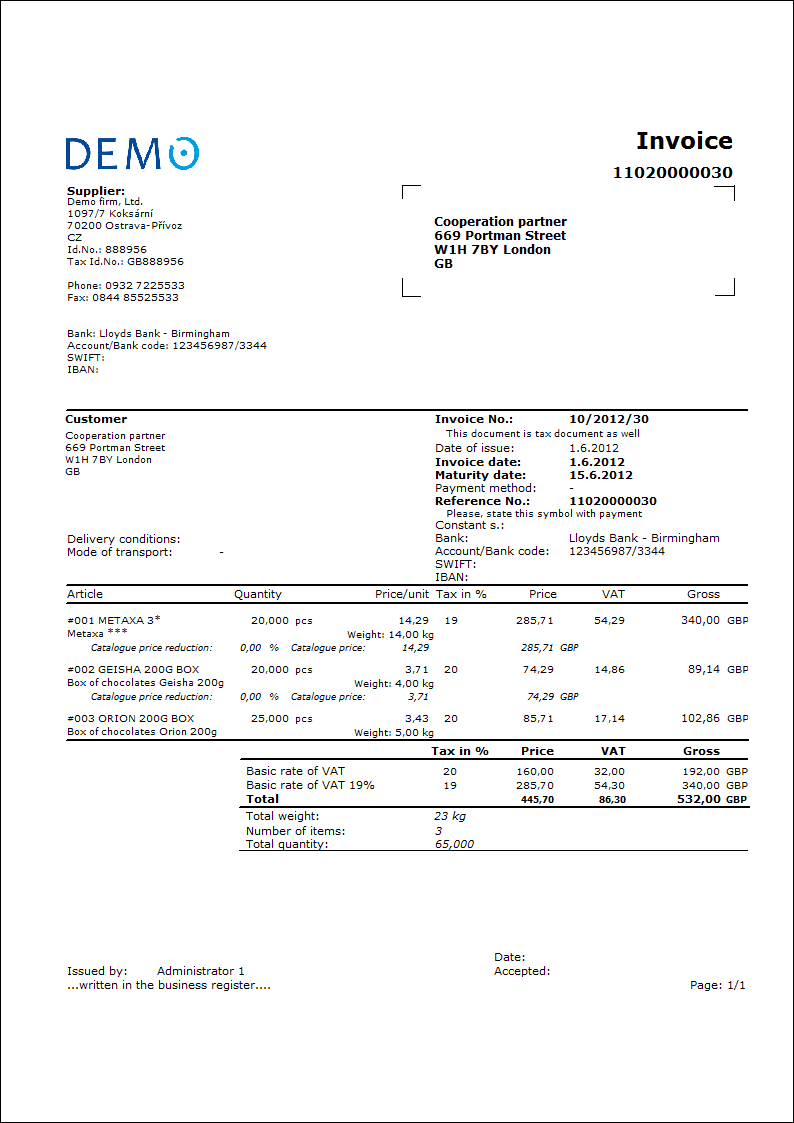Invoices Out
Book of Invoices out serves for issuing the invoices to the customers and for registration of these invoices. In that book it is possible to issue both bound invoices from the set Contracts and unassigned invoices without a Contract (the unassigned documents). The invoices serve as the tax documents in the accounting. Together the invoices form the evaluation of sale of goods, customers withdrawals and every according to the Invoice date.
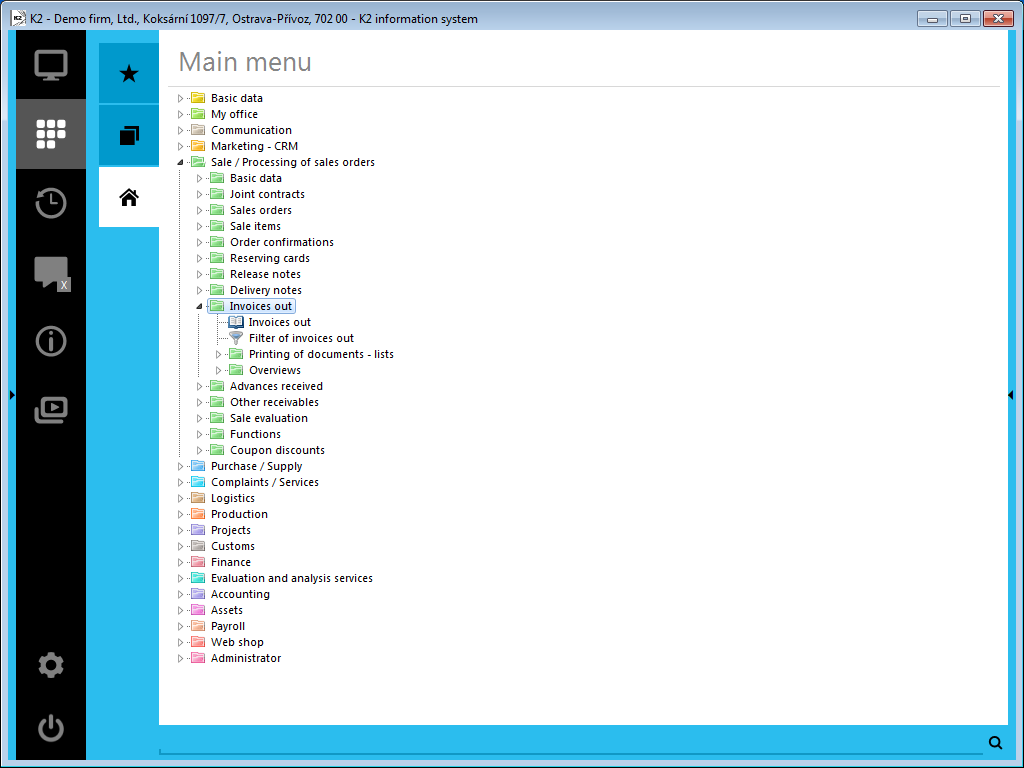
Picture: Opened menu of module Sale / Processing of sales orders - Invoices out
Invoices Out book
There are the items that are very similar to each other with their function in the both types of invoices (invoices out and invoices in) on the individual pages of the invoices. The same principle is valid for the design of particular pages and for the pattern of the information displayed on them.
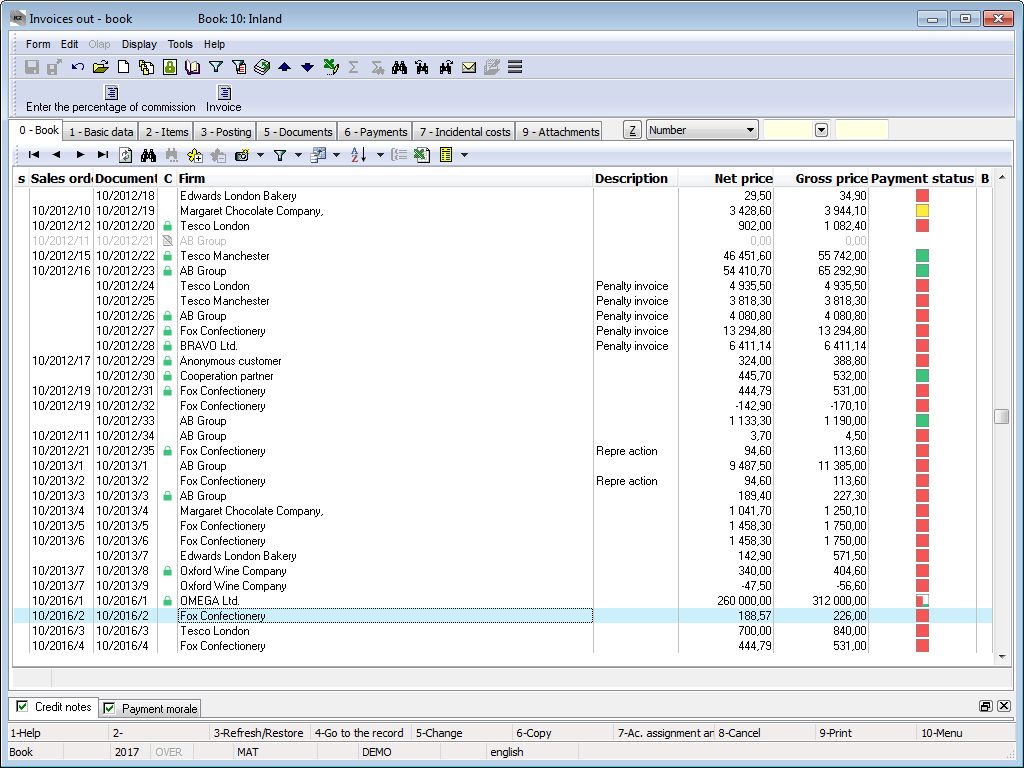
Picture: The Invoices Out book
Meaning of the graphic symbols of payments on the invoices out
![]() unpaid prior to maturity
unpaid prior to maturity
![]() not paid off prior to maturity
not paid off prior to maturity
![]() unpaid after maturity
unpaid after maturity
![]() not paid off after maturity
not paid off after maturity
![]() unpaid after x days after maturity
unpaid after x days after maturity
![]() not paid off after x days after maturity
not paid off after x days after maturity
![]() overpaid
overpaid
![]() paid
paid
Basic data (1st page)
The first page of the invoices serves to display the identifying and basic data about an invoice and some other information such a payment method, method of transport, date of issue etc.
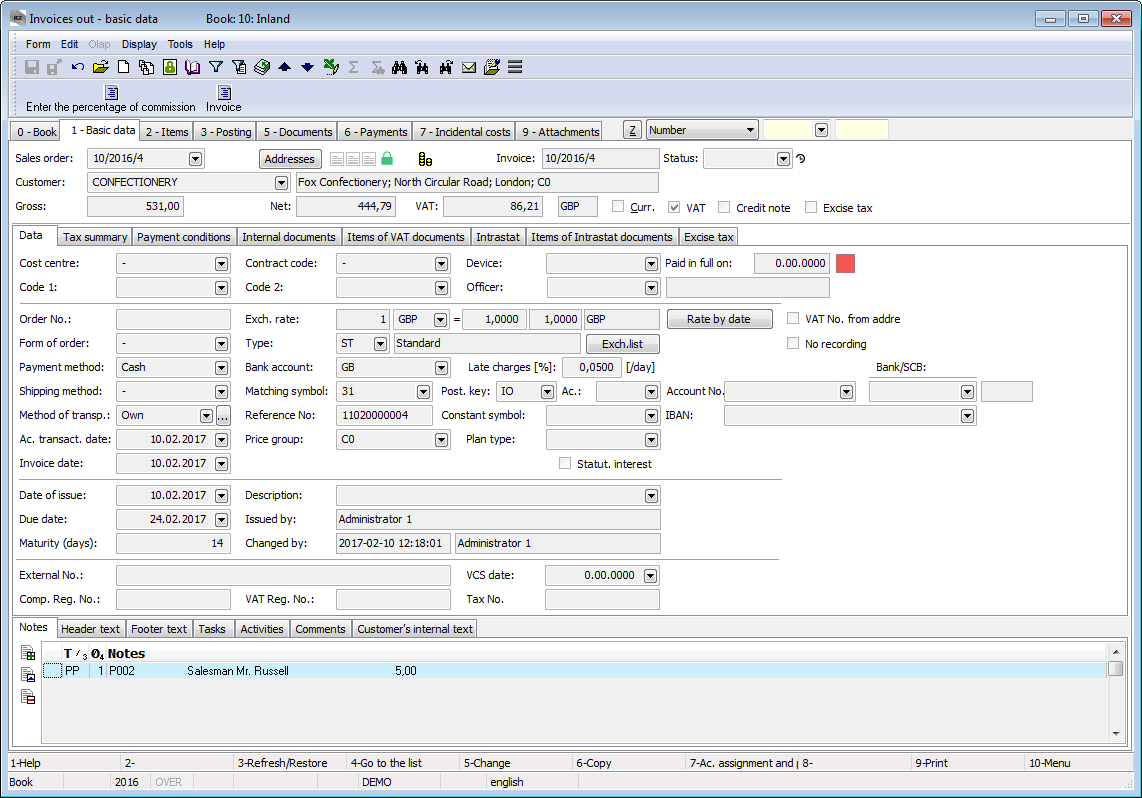
Picture: Invoices Out - 1st page
Fields Description:
Sales order |
The field serves to enter the number of the sales order, which the Invoice is linked with. If the invoice has been issued as a free document, this field will is empty. Note: Before creating an Invoice, it is defined, whether the document will be linked or free, by means of the wizard. It is not possible to change the Sales Order in Change mode yet. |
Addresses |
The button to display an addressee or the superior firm. For further information see the Addressee chapter. |
Invoice |
Book, Business Year and number of Invoice. |
Status |
Field for selection from a code list. This field enables to filter documents according to the selected status by a user. |
Customer |
A business partner name that is inserted by a selection from the Suppl./Cust. book. In the case of a new partner, it is possible to insert a next Supplier/Customer card into this book by pressing Ins key for inserting new record (eventually by F6 key - insertion according to the indicated specimen), edit a card (by pressing F5 key) or only browse a card (by pressing F4 key). |
Prices |
The amount on that the Invoice has been issued. The gross price, the net price and the amount of VAT are stated in this row. |
Currency |
The flag indicates that the Invoice is issued in a foreign currency. |
VAT |
If this field is checked, it is the common Invoice where the VAT is paid. |
Credit note |
If the field is checked, it is a Credit note. |
It is possible to assign random types and kinds of the notes to the Invoices, eventually it is possible to use the Header text or the Footer text. Further description of work with the notes is stated in the Basic Code Lists and Supporting Modules K2 – Notes chapter. Customer´s internal text tab serves to display customer´s internal text. The Tasks and Activities tabs are also available. The work with tabs is described in the Tasks - document's tab and Activities - document's tab chapters.
Payments conditions can be displayed on the Payment conditions tab.
Basic data of the header of Invoices Out are divided into several tabs.
The Data tab contains basic information of the document header.

Picture: Data - Invoice out (1st page)
Fields Description:
Cost centre |
This is also filled from the selection menu of cost centres. |
Contract code |
It is a random numeric or text code that serves for the sorting the activities of a company. |
Paid in full on |
The date of the real Invoice payment. |
Device |
A reference to the Device book. It is copied from the Sales Order to the inferior documents. |
Code 1, Code 2, Officer |
The fields enable the user identification, eventually a link to the Officers book. For further description see the Basic Code lists - Code 1, Code 2, Officer chapter. |
Order No. |
An Order Number that is typed manually. |
Form of Order |
The form in which the order for an article has been made. |
Payment Method |
The method of the invoice payment. Note: The Payment Method can influence the rounding of an invoice. For further description see the Rounding Inland Invoices Depending on Payment Method methodology. |
Method of Transport |
The mode of transport of the articles. Note: For the need of Intrastat it is possible to assign a mode of transport to each method of transport. |
Ac. transaction date |
The accounting transaction date enters into the accounting. It is possible to set the change of the date on an Invoice Out according to the confirmation date of a Release Note by pressing Shift+F2 in Change mode. |
Invoice Date |
Invoice Date enters into the VAT Return. If the Invoice Date is zero, the document does not enter into the VAT Return. |
External No. |
External number (60 character text). |
Comp. Reg. No. |
Comp. Reg. No. of a customer. If it is not entered, a Comp. Reg. No. from the Customer card is applicable. |
VAT Reg.No. |
VAT Reg.No. of a customer. If it is not entered, a VAT Reg. No. from the Customer card is applicable. |
Tax No. |
Tax No. of a customer. If it is not entered, a Tax No. from the Customer card is applicable. |
Maturity (days) |
Number of maturity days. The number of days, that is pre-set in the Client Parameters (the Administrator module), eventually from the Suppl./Cust. card, is automatically added. |
Exchange Rate |
The document currency and the exchange rate for a recalculation to the domestic currency. The rate, that is valid on the date of issue, is selected. If the Invoice exch. rate according to ac. trans. date parameter is set in the Client parameters, the exch. rate on the ac. trans. date is added. After the payment or the revaluation of a document, this field cannot be edited anymore. |
Rate by date |
This button enters an exchange rate from the Exchange List valid on the date depending on the Exchange rate according to accounting transaction date parameter. |
Exchange List |
This button opens the preview of exchange list of the given currency and sets the light indicator on the rate valid on the date of issue of an invoice. |
Type |
Type of tax determines into which line of the VAT Return the invoice will be loaded. |
Bank account |
The bank account of "our" company, to which the payment should be sent. If the Uniform bank connection for inv. out client parameter is set, the bank account from the customer in the own company will be added, otherwise the bank account set on the Suppl./Cust. card will be added. |
Late charges (%) |
The percentage of late charges (%) for each day of late payment from the maturity date - it is added from the Suppl./Cust. card. If the Statutory interest checkbox is set, the late charges is added from the Statutory interest table. |
Matching Symbol |
This field serves to enter a definition of a matching symbol for the accounting documents (see the Accounting - Matching Symbols chapter). |
Posting key |
When you select the posting key (by selecting from the selection menu), it will be set how the created Invoice will be posted. The Posting keys are set in the Accounting - Posting keys module. On the 1st page of the Books of Sale, there it is possible to set, which Posting key will be automatically filled in this field. |
Account |
This field is automatically filled according to the Account in the Book of sale. If it is not filled in the book, the Receivables account from the 1st page of the Suppl./Cust. card will be inserted. |
Reference Number |
A Reference Number for an Invoice - it can be created automatically according to the setting in the Books of Sale. It must be unique – the program alerts us to the contingent duplication of a Reference Numbers. |
Constant Symbol |
A Constant Symbol supplemented by the selection from the menu table (F12). |
Price Group |
The price group of the invoice header according to which the selling prices are set. That price group is copied into the individual items of a document. |
Plan type |
A Plan Type, which is defined in the given Book of Sale, is entered in this field by default (see the Basic Code Lists and Supporting Modules K2 - Plan Type chapter). The plan type serves for a classification of the documents. |
Date of Issue |
The date of issue of the invoice. The current date is automatically entered into this field. In case of need, it is possible to overwrite the date. |
Due date |
Due date of an Invoice. According to the Derive due date from Accounting trans. date client parameter settings, the Maturity date is automatically entered by adding the number of Maturity Days to the value of the Date of Issue field or to the Acc. trans. date field. If there is Floating maturity checked on the Payment conditions tab on the Suppl./Cust. card, then the the due date is entered according to the Month shift and Days from beginning of month values. |
Statut. interest |
Checkmark that determines, whether the late charges will be counted contractually or according to the law. |
Description |
The closer specification of the Invoice (a purpose of the Invoice issuing…) can be pasted to that field either manually or by selecting from the selection menu. |
VAT No. from Addressee |
VAT Reg.No. will be taken from an invoice address (if an invoice address is filled) if the Invoice is included in a Summary Report or in an Enclosure - Realized tax. suppl. - reverse charge system. |
No recording |
If this field is checked, the Invoice amount will not be added to the customer's turnovers displayed on the 2nd page of the Suppl./Cust. card. Simultaneously, confirmation of this Invoice with the checked field does not influence the value of the Last Price field on an Article card, Date of the Last price field and Date of the last purchase field. Also the Invoice will not be added to the credit on the 1st page of an Suppl./Cust. card when confirmation. |
Issued by |
A name of an employee who has issued the Invoice. |
Changed by |
The date and name of an employee who has made the last change of the Invoice. |
There are prices of an invoice without deduction of advances in the upper part of the Tax summary tab. The displayed Gross, Net and VAT values show an invoice amount without deducted advances.
There is a table of the price recapitulation of the invoice under this information.
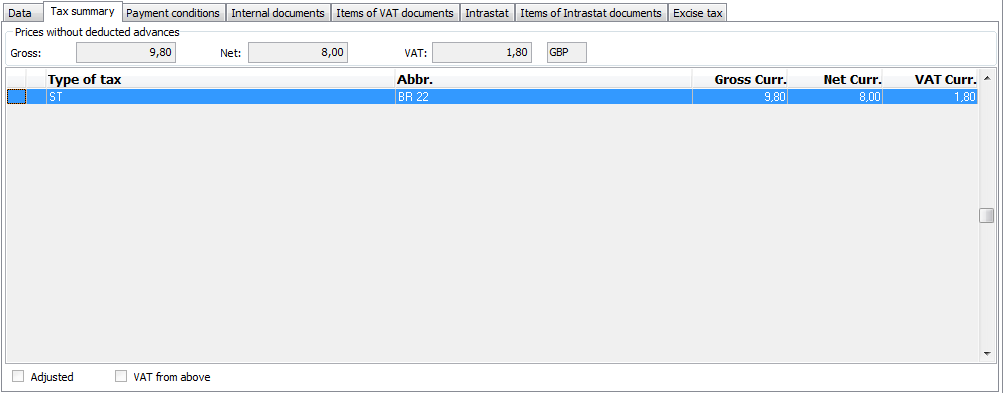
Picture: Tax summary - Invoice out (1st page)
It displays the VAT documents items, in which the invoice is entered.
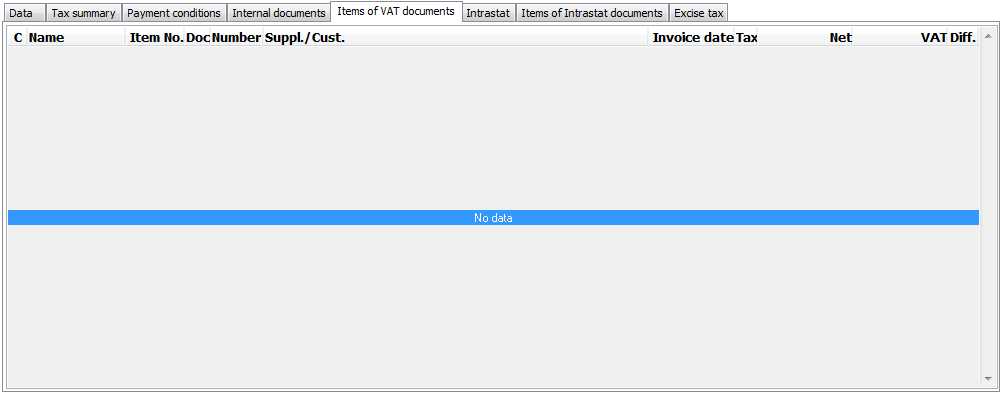
Picture: Invoice out - 1st page with Items of VAT documents tab
Internal documents, in which an invoice is stated in the heading of an internal document in the Document field, are displayed.
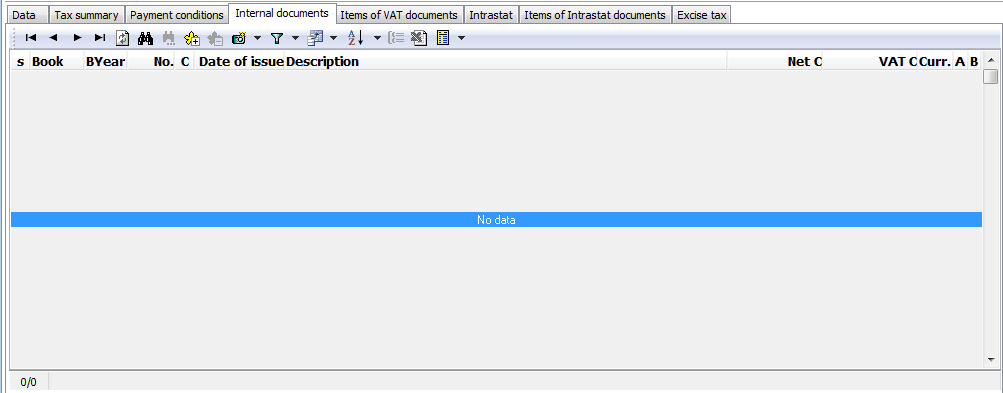
Picture: Invoice out - 1st page - Internal documents tab
The tab serves to enter data which are important for presenting Intrastat.
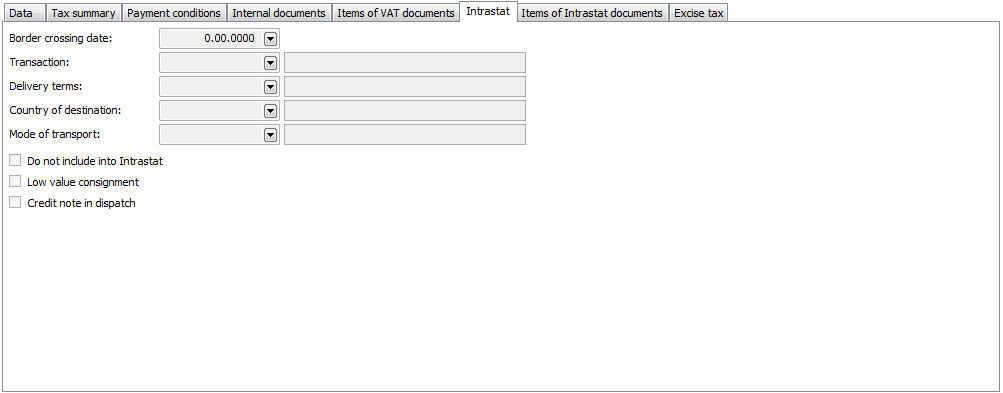
Picture: Invoice out - 1st page - Intrastat tab
Border crossing date |
Decision date for input of an invoice to Intrastat. It is filled with the date of issue of an invoice. If the Border crossing date according to invoice date client parameter is checked, then it is filled with this date. |
Transaction |
Type of transaction of an invoice. |
Delivery terms |
Delivery terms for an invoice. |
Country of destination |
A country of destination for an invoice. It may be filled in, if the country of destination is different, than the country in the customer address (eventually in the delivery address, if it is entered). |
Mode of transport |
Mode of transport for an invoice. It may be filled in, if the Mode of transport is not entered in the Method of transport code list. |
Do not include into Intrastat |
The checked field ensures, that the document does not enter into Intrastat (even if it should enter there according to the other conditions). |
Low value consignment |
Data about the individual consignment of the dispatched goods, invoice value of which does not exceed 200 EUR, can be characterized summarily as Low value consignment under the common article code "99500000". The check, whether the invoice satisfies the conditions for Low value consignment, will be executed by checking the flag. If the invoice does not satisfy the conditions, the items in Intrastat will be loaded separately. |
Credit note in dispatch |
The checked field ensures, that the item of the invoice out with the negative quantity will get into Intrastat - dispatches. If the field is not checked, then the given item will enter into Intrastat - arrivals. Note: It is appropriate to use it in the case, that the company shows only Intrastat - dispatches. |
It displays Intrastat document items, in which the given invoice out is entered.
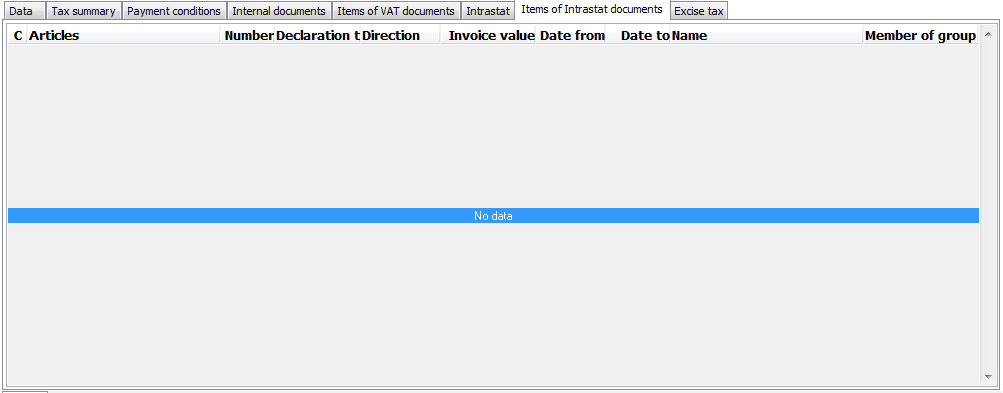
Picture: The Invoice out - the 1st page with Items of Intrastat documents tab
Recapitulation of the Excise tax is displayed.
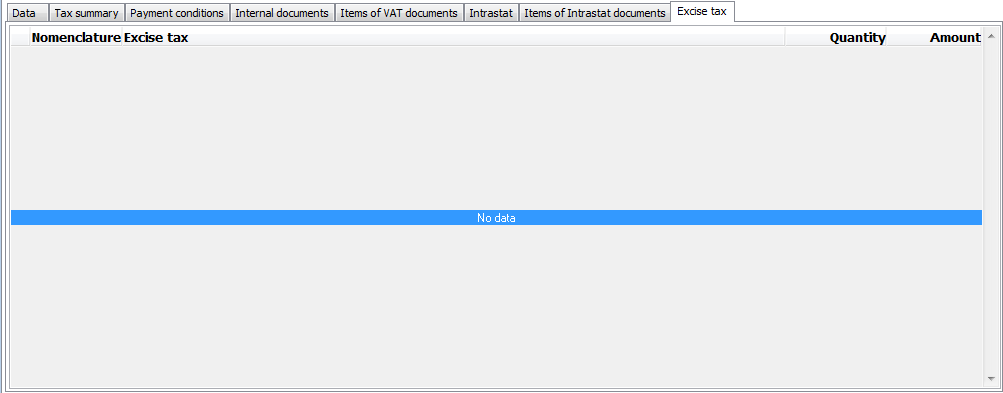
Picture: Invoice Out - 1st page - Excise Tax
Items (2nd Page)
On the second page of the invoices you can find a list of the particular items, for which the invoice has been issued. A new item can be inserted in Change mode or in a New record by using Ins key. If you issue a free document, the Sale item form, in which the required articles will be selected and the required data will be entered, is displayed. If you issue a linked document, the items are selected from the Heading items book after pressing Ins key. All items, that are inserted on the Sales order,but no invoice has been issued for them yet,are stated here.
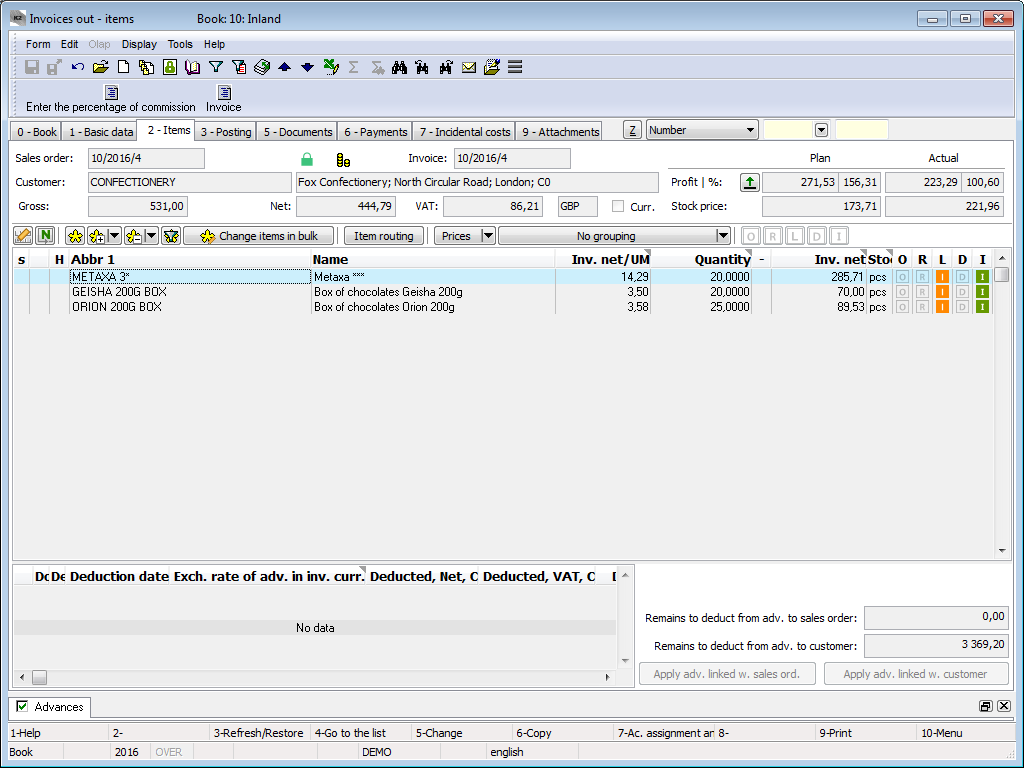
Picture: Invoices Out - 2nd page
The Sale Item form can be also activated by pressing Enter key on the individual items of an invoice either in Change mode or in Browse mode. In addition, in Change mode it is possible to edit the data about the invoiced prices, quantity, it is possible to add the codes etc.
Data about a planned and actual profit and margin of a document may be displayed in the header of a document. See the further description in the Profit, Margin and Stock Price chapter.
Values in the documents items including discount can be adjusted in bulk by means of Change items in bulk button in Change mode. For the further description of this function see the Change Items in Bulk and Purchase and Sale Items chapters.
There is a list of the deducted advances in the lower part of the 2nd page of an invoice and there are the amounts which you can deduct (the amounts are stated in a currency of the Invoice) on the right part. The buttons for deduction of advance are accessible in Change mode.
Selected fields' description:
Apply adv. linked w. sales order |
After pressing the buttons, the advances to a sales order, with which an invoice is linked, will be offered to deduction. |
Apply adv. linked w. customer |
After pressing the buttons, the advances to customer will be offered. |
Remains to deduct from adv. to sales order |
The amount of the paid advances to a sales order that has not been deducted on an Invoice yet. |
Remains to deduct from adv. to customer |
Amount of the paid Advances to a Customer which has not been deducted on an Invoice yet. |
Further description of deduction of advance is stated in the Deduction of an advance received on an invoice out chapter.
Account assignment (3rd page)
The 3rd page, that is optically split into two parts, is used for posting of invoices. There are the individual items of an Invoice in the upper part. The deducted advances are displayed under that. The lower part serves for the posting of a document.
Note: The further description of the account assignment and posting is stated in the Accounting - Account assignment and posting chapter.
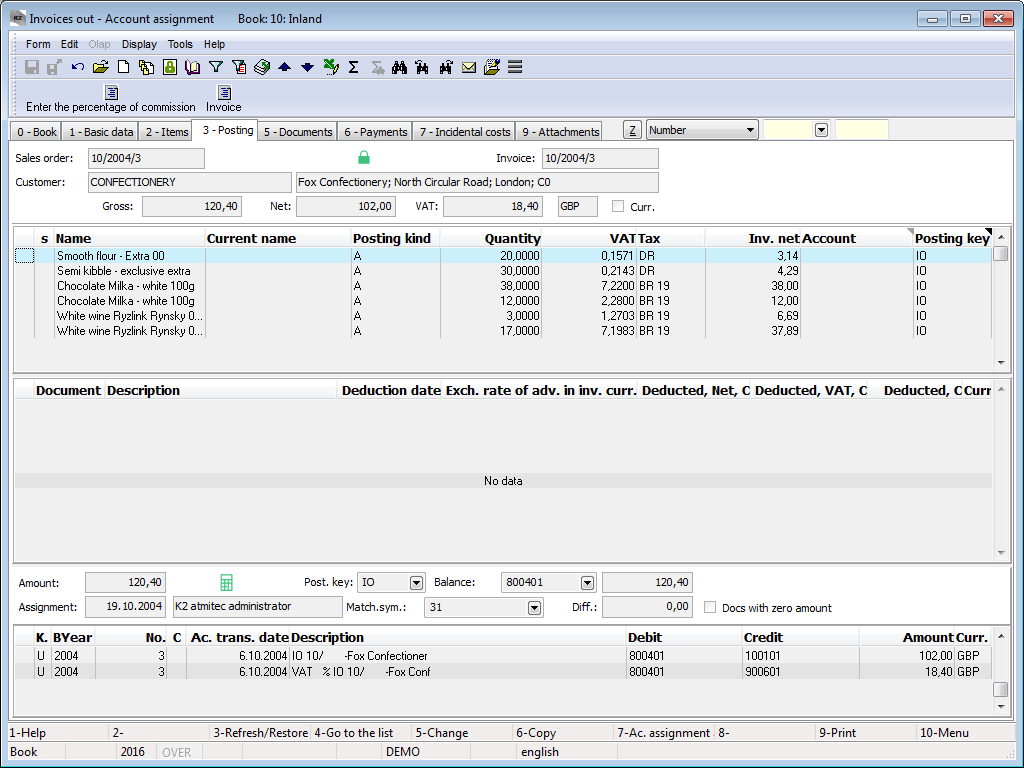
Picture: Invoices Out - 3rd page
Documents (5th Page)
There is a list of all documents, that are linked with this invoice through the superior document (Sales order), on the 5th page of an invoice out. Switching among the individual documents can be executed by the simultaneous pressing Ctrl key and a beginning letter of the document. The selected document can be also displayed by Ctrl+Enter key combination.
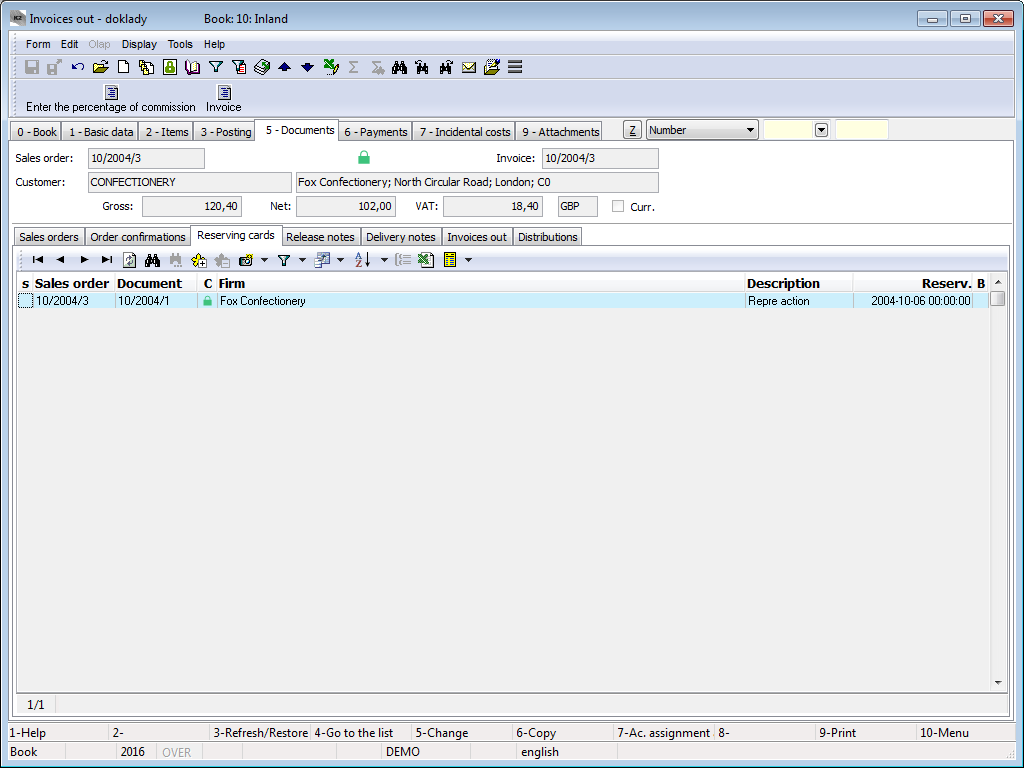
Picture: Invoices out - 5th page with the open Reserving cards tab
Payments (6th page)
On 6th page of the invoice, the user can monitor the matters related to the state of the invoice payment as the facts whether the invoice has been paid in full or only in part, the due date, the delay, the penalty or the information about the specific payments (the lower part of the screen). This page is displayed in Browse mode only (it is not accessible in Change mode or in New document).
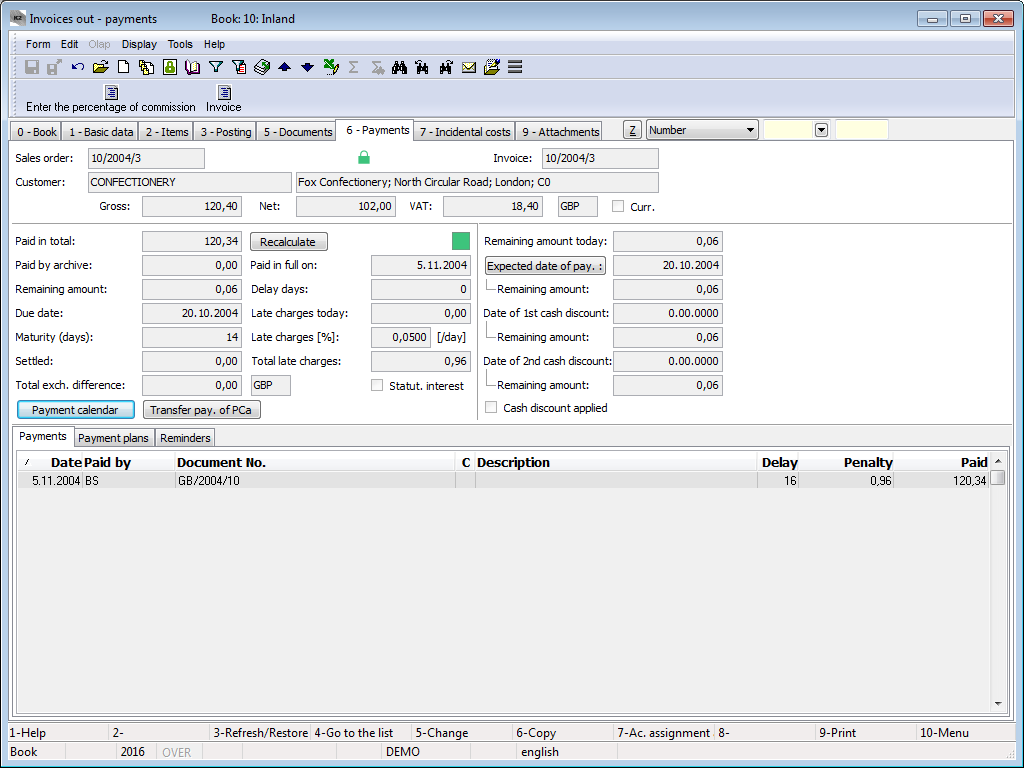
Picture: Invoices Out - 6th page
Fields Description:
Paid in total |
The total amount which has been already paid. |
Paid by archive |
The amount paid by the documents, which have been already moved to an archive. |
Remaining amount |
The amount that remains to pay. |
Due date |
Due date of an Invoice. |
Maturity Days |
The number of maturity days in which the invoice should be paid. |
Settled |
The amount that has been paid by banker's orders. |
Total exch. difference |
Total amount of an exch. difference expressed in numbers to the invoice. |
Recalculate |
The Recalculate button executes a recalculation of the payments to the invoice. The recalculation can be also run by using Ctrl + F3 key combination on the 6th page of an invoice. If there is an exclamation mark next to the button, the payments on the 6th page are not loaded correctly - it is necessary to run the payments recalculation. |
Paid in full on |
The real date of the invoice payment. |
Delay days |
The delay of payment in days. |
Late charges today |
Total late charges. |
Late charges |
Contractual late charges specified in % per each day of delay .. |
Total late charges |
The amount of late charges calculated from the entered percentage and the delay days on the date of payment. |
Statut. interest |
If this field is checked, the interest provided by law will be added to the invoice. |
Remaining amount today |
The amount, which remains to be paid on the current date. |
Expected date of pay |
Expected date of pay. Due day is automatically filled. It is possible to change it. According to the date indicated in this field, the amount in the field under that is displayed. It is an amount which remains to pay on this date. |
Date of first discount |
Date of the first discount according to the payment conditions entered on the 1st page of the invoice. If no payment conditions are defined, then this date is identical to the due date. The amount indicated in the field thereunder is an amount to be paid to this date. |
Date of second discount |
Date of second discount according to the payment conditions entered on the 1st page of the invoice. If no payment conditions are defined, then this date is identical to the due date. The amount indicated in the field thereunder is an amount to be paid to this date. |
Discount applied |
The field serves for marking documents which fulfilled conditions of discount and a discount has been already applied on them. The field cannot be edited by a user. |
The Payment Calendar button is used to switch over to the 1st page of a corresponding item of Payment Calendar.
The form to transfer payments of Payment Calendar will be displayed after pressing the Transfer pay. of PCa button. Select a payment calendar item, payments of which you want to transfer into the current invoice. By pressing OK button, all payments of Payment calendar item, that have been executed, will be transferred on a current Invoice. The item of Payment Calendar, from which the payments have been transferred, may be invalidated by checking the Make original doc. invalid option. It is possible to transfer payments from income to an invoice out (and other way round) or from a release to an invoice in (and other way round).
Note: If a rounding error is defined in the Client Parameters, then if the Amount in the Remaining amount field (on the 6th page of an Invoice) is less than the defined rounding error, the Invoices are indicated as paid.
The bottom part of the 6th page is divided into 3 tabs:
- Payments,
- Payment plans,
- Reminders.
There are individual payments of an Invoice in the Payments tab. After pressing the Enter key in Browse mode on a specific payment, the 2nd page of a Bank Statement, a Cash Voucher or an Internal Document, eventually of a Banker's order, by which the payment has been executed, will be displayed. In the cash voucher (bank statement or the banker's order), the light indicator will be positioned on the item that corresponds to the Invoice payment.
It is possible to insert items, that will indicate the plans of a Payment Calendar, by pressing Ins key in the Payment plans tab in the Change mode (switch into Change mode directly on the 6th page). For each plan define the date, currency and amount, that you will want to pay in the future. The created plans will be displayed on the 2nd page of Payment Calendar as well. As well as if you create items in the upper window on the 2nd page of a Payment Calendar, these items will be also displayed on the 6th page of an Invoice in this tab.

Picture: The form for creating the plan of a payment calendar
The individual reminders, that have been issued for an Invoice, are displayed in the Reminders tab. By using the Ctrl+Enter keys, you can switch into the books of Reminders with the light indicator positioned on a specific Reminder.
Settlement of the invoices can be executed not only in the Finance module by using the banker´s orders, bank statements and cash vouchers, but it is also possible to use the function for automatic payment directly on the invoices out (in). That function can be activated in the following ways:
- The Automatic payment by cash register function can be run from the 6th page of an invoice by using Shift+F2 key combination. The Automatic payment form will be displayed after the pressing the keys and the payment of the current document will be executed by a cash voucher after filling in the data of this form.
- The Automatic payment by internal document function can be run from the 6th page of an invoice by using Shift+F3 key combination. The Automatic payment form will be displayed after the pressing the keys and the payment of the current document will be executed by an internal document after filling in the data of this form.
- It is run through the module Menu Form - Bulk actions - Payment by cash register. In this case it is possible to activate the bulk payment of the invoices either in the table of the invoices, if the invoices are indicated by asterisks, or on the filter.
- It is run through the module Menu Form - Bulk actions - Payment by internal document. In this case it is possible to activate the bulk payment of the invoices either in the table of the invoices, if the invoices are indicated by asterisks, or on the filter.
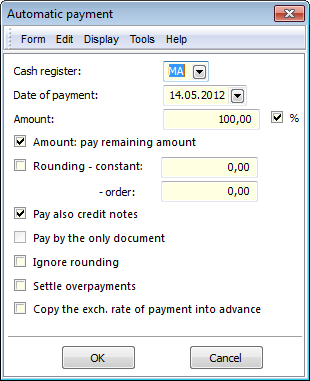
Picture: Automatic payment form - Shift+F2
Fields Description:
Cash Register |
Selection of the Cash Register (from the table Books of Cash Register) by which the payment will be executed. |
Date of payment |
The date of the payment. |
Amount |
The amount that is to be paid. To the field, it is possible to write either the amount in invoiced currency or the percentage of the payment (e.g. to pay 20% of the total invoice amount). In the case, that more invoices are paid in bulk by entering amount (not %), documents with the negative remaining amount are excluded from the payment (they are displayed in the error message). |
Amount: pay remaining amount |
The option for the payment of a remaining amount of an invoice (it is used for the invoices that have been already partially paid). This option can be combined with the previous one when it is possible to pay e.g. 50% of the remaining amount. |
Round payment amount to integer units |
Payment amount will be rounded to whole units. |
Pay also credit notes |
If an invoice is issued as a credit note, then it is not possible to pay it without activating this flag. |
Pay by the only document |
This option is available upon the automatic payment, that can be activated on the filter of invoices by means of the bulk actions or upon the payment of invoices indicated by asterisks. If you set that option, the selected invoices will be paid by one document. Vice versa one separate cash voucher will be issued for every invoice. |
Settle overpayments |
Option to flatten heller arrears. If it is checked, the documents, which remaining amount is less (or equal) than rounding error, will be settled. |
Copy exch. rate of payment into the advance. |
This option is for the payments of advances in a foreign currency - it sets an exch. rate according to the advance payment on the paid advance (no exchange differences should be created when payment of an advance). |
Note: If the records are indicated by asterisks - the function pays documents from the last asterisk. If the records are in the evaluation filter, the function pays documents from the first document.
A form of the automatic payment by internal document is similar, the Document currency can be specified in addition (it means a currency of an internal document).

Picture: Form for the Automatic payment by internal document
Ext. documents (9th Page)
External documents and other documents can be assigned onto 9th page within IS K2. Further description is stated in the chapter Basic Code Lists and Supporting Modules K2 – 9th Page.
Instalment selling, suspensions
Installment invoices and suspensions are issued in the case, that we agreed with the customer about the suspension of payments.
Example: We have concluded the contract for a delivery of goods in the worth of 312,000.00 GBP (incl. VAT) with the customer. After performance of the subject matter of a contract, the customer has to pay 237,000.00 GBP. The amount of 75,000.00 GBP will be paid by the customer later in the five equal monthly instalments.
Setting of the K2 IS:
- The instalments will be registered by using Other Receivables documents - create a separate Book of other receivables, where set:
- Tax type = "N" (Not in declaration of taxes),
- the Posting key field stays empty (instalments are not booked),
- Account = an account for deffered payments,
- Other receiv. date = "Zero date",
- the Reference number field stays empty.

Picture: General settings of the Books of other receivables, determined for the instalments registration
- Further create a card of other receivable for the instalments. Open the Cards of other receivables code list from the tree menu Sale / Other receivables. Create a new card and there enter an Abbreviation, Name, VAT rate = "N" (0 %).
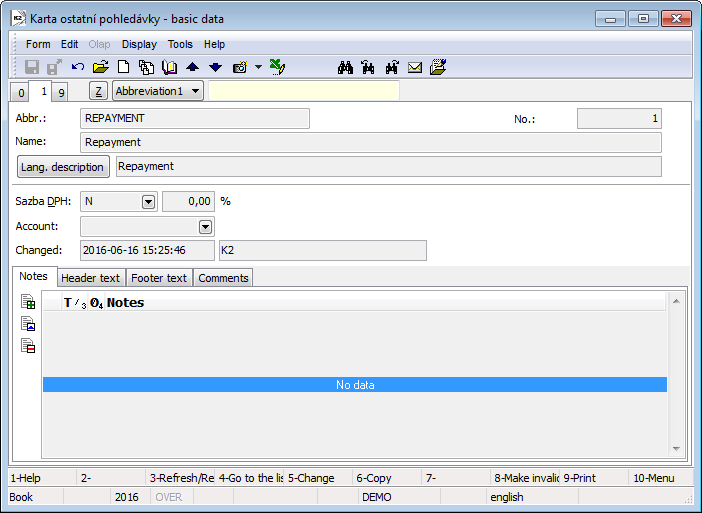
Picture: Cards of other receivables - Instalment
- Create a separate Book of internal documents, in which the payments of instalments will be registered. In the book of internal documents set:
- Posting key = "O",
- Debit account= an account for deffered payments in the Sale (311_2),
- Credit account = an account for deffered payments in the Purchase (321_2),
- Add the Create other receivable / liability from invoice script into F9 or in user's toolbar and set these parameters:
- Book = Abbreviation of the book of other receivables, created for instalments,
- Card = Abbreviation of the card of other receivables, created for instalments.

Picture: The parameter settings of the Create other receivable / liability from an invoice script
Procedure:
- Create the Sales order, in which the subject of agreement will be specified, in the Sale module. Issue an invoice for the articles after fulfilment of the subject of agreement, than confirm the invoice.

Picture: Invoice Out - 2nd page
- This invoice will be partially paid by the internal document - in the amount of the deffered payments (75,000.00 GBP): Run the Automatic payment by internal document on the 6th page by using Shift+F3 key combination. In the input form select a Book of internal documents and enter the Amount.
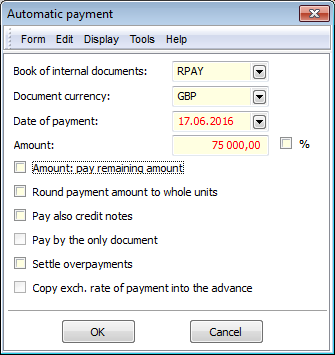
Picture: Form of the Automatic payment by internal document function
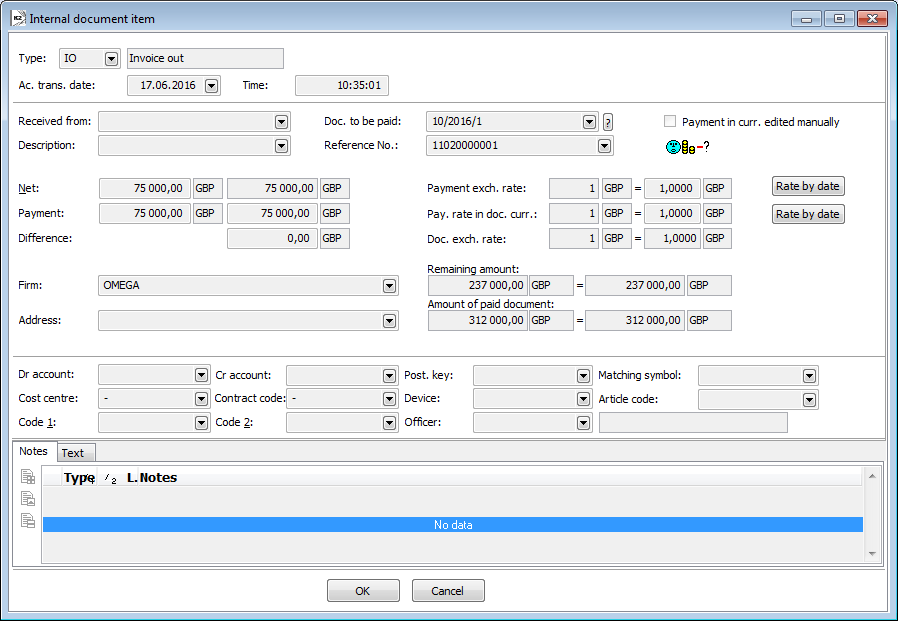
Picture: Internal document - item
- Then add the Payment parameter with the value "1" on the Invoice out report. (This parameter changes the "Paid" text to the "Deffered payments" text.) Print the invoice for the articles.

Picture: Invoice Out report with parameter Payment = "1"
- Run the Create other receivable / liability from an invoice script on an invoice out. In the input form of the function set:
- Date of accounting transaction of the first instalment,
- Due date of the first instalment,
- Amount of the first instalment ("15,000").
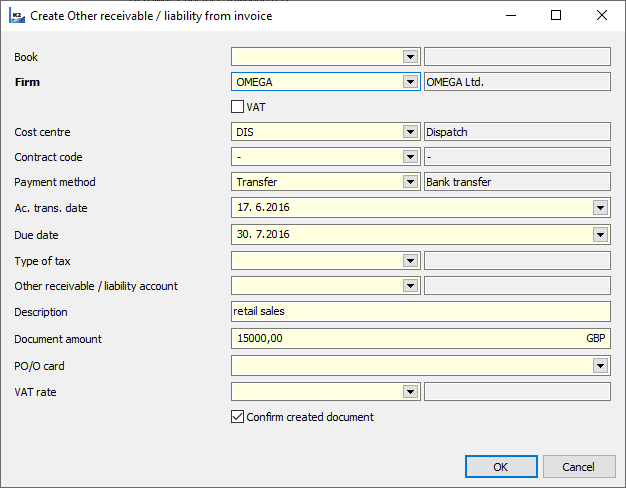
Picture: The input form of the Create other receivable / liability from an invoice
- The 1st instalment will be created in the book of other receivables after the approval of a form, there is a link to the invoice out in the header of receivable in the Document field.

Picture: Other receivable - 1st deferred payment
- On the other receivable - 1st instalment - run the function for creating repeated documents by using Shift+F4 keys. In the input form of the function:
- check the Monthly recurrence,
- check the Number of new documents and set the value "4",
- check Confirm documents.
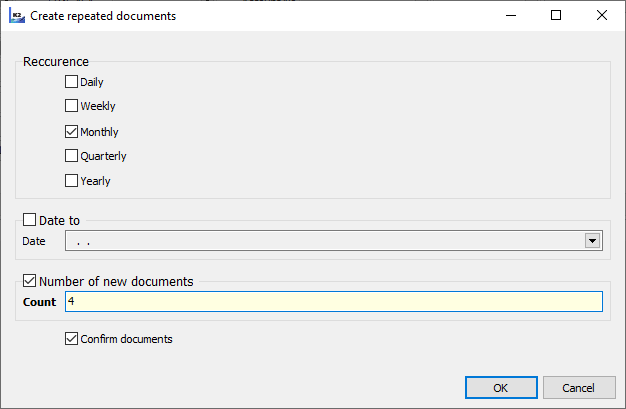
Picture: The input form of the Create repeated documents function
- 4 documents - instalments - will be created after the approval of a form. A customer pays off by instalments according to the repayment plan. Payments are matched with the other receivable documents - Deffered payments.
Posting:
For posting use the following accounts:
311_1 |
- |
Customers |
311__2 |
- |
Deferred payments |
Invoice for the articles |
311__1/604 |
260,000.00 GBP |
|
311__1/343 |
52,000.00 GBP |
Payment by internal document - deferred payments |
311__2/311__1 |
75,000.00 GBP |
Payment of Invoice for the articles |
221/311__1 |
237,000.00 GBP |
Other receivables - deferred payments |
do not post |
5 x 15,000.00 GBP |
Payments of the deferred payments |
221/311__2 |
5 x 15,000.00 GBP |
When the suspension of payments by reason of suspensions proceed in a similar manner. Only when printing the invoice for the goods, the Payment parameter should be set on the value "2". (This parameter changes the "Paid" text to the "Suspensions" text.)
Process No.: ZAK019, FIN016 |
Script Id: FZAK019 |
File: FA_CreateOteherRelation.PAS |
Script description: The script can be run from an invoice out. A form, where a Firm, Cost centre, Contract code, Payment method and Description are set according to an invoice, is displayed after running the script. Set the book, in which the receivable should be created, date, amount, VAT rate or the card of other receivables, eventually other data. An other receivable document will be created after the approval of a form. If no Tax type and no Account are defined, they will be added according to the defined book, in which the document will be created. Invoice date is filled in dependence on the Invoice date parameter set in the book. |
||
Address in the tree: [Sale] [Other Receivables] |
||
Script parameters:
Account - Account for other receivables / other liabilities. |
Amount - 0 Amount of a document. |
Bank - bank code from an invoice in Bank code for other liability. |
BankAccount - bank account for an invoice in Bank account for other liability. |
Book - Abbreviation of a book of other receivables / liabilities. |
Card - Abbreviation of a card of other receivable / liability. |
Confirm - Yes Yes - the created document will be confirmed. |
ContractCode - contract code from an invoice Abbreviation of Contract Code. |
CostCentre - cost centre from an invoice Abbreviation of Cost Centre. |
Description - description from an invoice Description of a document. |
Firm - firm from an invoice Firm of a document. |
InvoiceDate - the current date Ac. trans. date of a document. |
MaturityDate - current day The Due Date of the document. |
NoInteractive - No Yes - the input form is displayed. |
PayMethod - payment method from an invoice Description of a document. |
RateOfVat - Abbreviation of a VAT rate for a document item. |
TypeOfTax - The type of the tax for a document. |
Vat - No Yes - a VAT flag will be checked in the heading of a document. |
Functions of the Module Menu Invoices Out
The bulk actions are executable only over the evaluation filter or over the records indicated by asterisk.
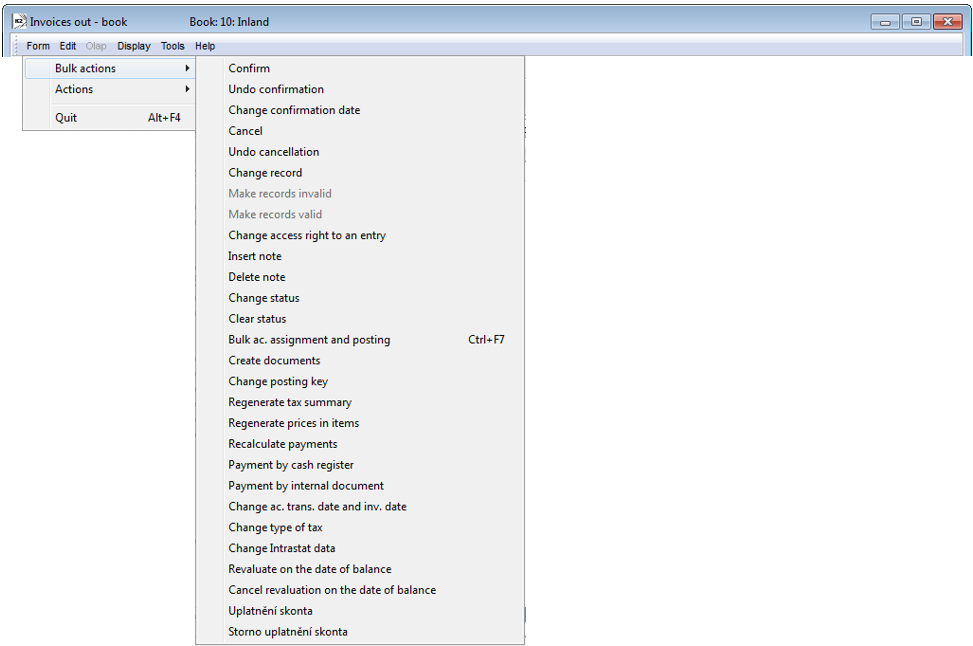
Picture: Functions of Invoices Out Module Menu
Actions Description:
Recalculate payments |
The function for the mass recalculation of the payments of the invoices out. |
Payment by cash register |
It makes automatic payment of invoices by cash register. Further description is stated in the Invoice payments - Automatic payment by cash register and internal document chapter. |
Payment by internal document
|
It makes automatic payment of invoices by internal document. Further description is stated in the Invoice payments - Automatic payment by cash register and internal document chapter. In context of these functions, the Documents not paid off and documents overpaid selection is set. After running the selection, the user defines ac. transaction date, from which he wants to select the documents, and interval of Remaining amount field (e.g. from -1 to 1). The created selection will contain documents not paid off or overpaid, which may be paid in bulk by internal document after indication by asterisks. |
Change accounting transaction date and invoice date |
On the unconfirmed Invoices, this function enables to edit:
VAT and Gross amounts will be recalculated after the change of VAT rate. If there is an unconfirmed Order confirmation or a Delivery note on an invoice item, then the amounts on these documents will be also changed. |
Change type of tax |
Function for the change a type of tax in bulk. The change will be reflected in the heading of a document and in a Tax summary too. |
Change Intrastat data |
It performs change record of the fields which are related to Intrastat (see the Intrastat chapter on the 1st page of the invoice out). The user, who wants to run the bulk change, must have the right Change Intrastat documents or Bulk change of invoices. |
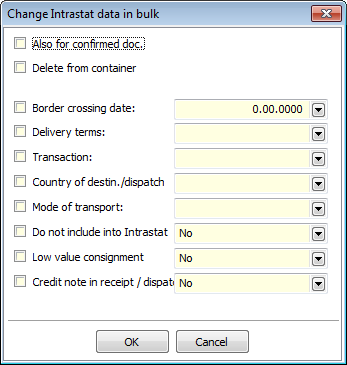
Picture: Form to change the Intrastat data
Fields Description:
Also for confirmed documents |
Changes will be also executed into the confirmed documents. Note: If the field is not checked and Change record should be executed over documents, which contain an confirmed document, an error message which draws attention to the confirmed document, will be displayed. |
Delete from filter |
After the change execution the filter will be emptied. |
Border crossing date |
Value, which will be inserted into the Border crossing date field on an invoice. |
Delivery terms |
Value, which will be inserted into the Delivery terms field on an invoice. |
Transaction |
Value, which will be inserted into the Transaction field on an invoice. |
Country of destination/dispatch |
A value which will be added into the Country of destination field (in the case, that a bulk action is run on an invoice out). A value which will be added into the Country of dispatch field (in the case, that a bulk action is run on an invoice in). |
Do not include into Intrastat |
Yes - the flag in the Do not include into Intrastat checkbox on an invoice is set, No - the checkbox is not set. |
Low value consignment |
Yes - the flag in the Low value consignment checkbox on an invoice is set, No - the checkbox is not set. |
Credit note in receipt/dispatch |
Yes - a flag in the Credit note in dispatch field will be set (in the case, that a bulk action is run on an invoice out). Yes - a flag in the Credit note in receipt field will be set (in the case, that a bulk action is run on an invoice in). |
Description of Other Actions:
Revaluate on the date of balance |
It performs the revaluation of invoices on the date of balance by an internal document. The further description is stated in the Accounting - Revaluate on the date of balance part. |
Cancel revaluation on the date of balance |
It executes a cancellation of Revaluation on the date of balance. The further description is stated in the Accounting - Revaluate on the date of balance part. |
Functions over Invoices Out
Description of functions:
Alt+F6 |
Transfer invoice payments by cash register (Book and Browse mode). |
Ctrl+F3 |
On the 6th page in Browse mode, this key combination activates the recalculation of the invoice payments. |
Ctrl+F6 |
Transfer invoice payments by cash register (Book and Browse mode). |
Shift+F2 |
It activates the form for a change of the Invoice date (in the book and on the 1st page in Browse mode). It is executable above the credit notes only. This key combination activates the function for automatic payment of invoices by cash register on the 6th page in Browse mode. |
Shift+F3 |
This key combination activates the function for automatic payment of invoices by internal document on the 6th page in Browse mode. |
Shift+F5 |
In the book, it activates the form for a reminders creation. |
Ctrl+Shift+Alt+F5 |
On the 6th page in Browse mode, it activates the form for Change of payment by archive. |
Ctrl+F8 |
On the 2nd page in Browse mode, it activates the form for a creating a new Service Sheet. It is necessary to set the Complaint/Service module for this functionality. |
F5 |
If you press this key on the 6th page of an Invoice, the document gets into Change mode. It is possible to insert the payment plans in Change mode. The key works on a confirmed and unconfirmed document too. |
Ctrl+Alt+F5 |
The function enables to select a Status of a document. |
Cancel Invoices (F8)
If the invoice has been already saved (the number has been assigned to it), it can not be deleted by any procedure. Only if it is not confirmed, it is possible to cancel it by pressing F8 key. The cancelled invoice remains in the database with the same data, only a flag of the cancellation has been assigned to it. Thus it is always possible to find out the amount, for which it has been issued, and its content. The cancelled invoice can not be changed any more just like when confirmation. By re-pressing the F8 key, the authorized person can undo cancel the invoice. The procedure is the same as when undoconfirmation.
If a document with the allocated incidental costs is cancelled, then these incidental costs are automatically deleted. It appears from this that such a document can not be cancelled in the case, when the user has not the right to Allocate incidental costs or the Incidental costs are allocated into the item of a receipt card, which is in the blocked period.
If an invoice has been created by mistake and it is not desirable that the invoice would be cancelled in the table of invoices, it is possible to link it to the other Order confirmation by using Matching - Alt+F5 and use the created number for an other invoice.
Transfer invoice payments Alt+F6 (Ctrl+F6)
The Transfer invoice payments function enables to transfer payments from one invoice to other one. Transfer is executed by cash voucher.
That function can be activated in Browse mode by pressing Alt+F6 (or Ctrl+F6) - the Transfer invoice payments form will be displayed.
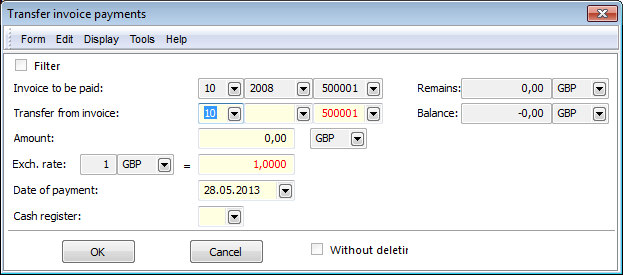
Picture: Transfer invoice payments form - Alt+F6 (Ctrl+F6)
Fields Description:
Invoice to be paid |
A book, a number and a business year of the current invoice (the invoice to which the payment is transferred). |
Remaining amount |
The remaining amount which is still to be paid on the current invoice. It is only displayed in the form. |
Transfer from Invoice |
The field for selection of the invoice, from which the transfer of payment should be executed. |
Remaining amount |
The remaining amount which is still to be paid on the selected invoice. It is only displayed in the form. |
Amount |
The invoice amount which should be transferred between the invoices. The Amount, that will pay this Invoice, is set by default (the amount that is entered in the Remaining amount field). |
Exchange Rate |
The exchange rate and currency of payment in the cash register. Currency is set according to the paid invoice and it can not be edited. |
Date of payment |
The date of the payment. |
Cash Register |
Selection of the Cash Register (from the table of Books of Cash Register) by which the transfer should be made. |
After the transfer execution a cash voucher will be created (in the Cash Register that has been selected in the form). There will be two items with the same amounts but with reverse signs on this cash voucher. This Cash Voucher is automatically confirmed if the Confirm automatically field is checked on the 2nd page in the definition of Cash Registers.
Invoices export into ISDOC format
Process No.: ZAK015 |
Script Id: FZAK040 |
File: FAV_ExportXML.pas |
Script description: The script enables the export of invoices out into ISDOC format, which is structured the "*.XML" file. Deducted advances are exported as well. |
||
Address in the tree: |
||
Script parameters:
Path - C:\ Set the way, where the file(s) should be exported. |
PaymentsInCash Set the value for payment in cash (divided by semicolon). |
TransferToAccount Set the value for Transfer payment (divided by semicolon). |
NonTaxedType - N An Abbreviation of a Tax type in the K2 for a type Not to assort into the Returns. |
PaymentsByCheck The parameter for a payment method - Payment by check (divided by semicolon). |
DocSupplementType - ALL Type of documents that will be exported from the 9th page of invoice (divided by semicolon in the parameter). |
OnlyConfirmed - Yes The parameter says, if just the confirmed invoices are exported. |
PaymentsByCreditCard The parameter for a payment method - Payment by credit card (divided by semicolon). |
AccountsBetweenPartners The parameter for a payment method - Accounts between partners (divided by semicolon). |
AlternativeItemDescription - No Yes - the name from invoice will be added into the item's description. |
DeliveryNoteType - 1 The link from the Invoice item: 1 - Delivery Note; 2 - Release Note. |
GenerateOnlyISDOCFile - No Yes - generates just the ISDOC file. |
PrimarySellersItemIdField Name of field with the primary identifier of an item. |
SecondarySellersItemIdField Name of field with the second identifier of an item. |
TertiarySellersItemIdField Name of field with the third identifier of an item |
AddNoteToDoc After the export, the note about executed export is inserted into the document. |
The user should set some parameters to have them right before he/she runs the script. They are:
- TransferToAccount - the user defines here the abbreviation used for the transfer method of payment.
- PaymentsInCash - the user defines here the abbreviation used for the method of payment in cash.
- DocSupplementType - defines the types of documents on the 9th page of invoice, which are exported together with the particular invoice.
- Path - the parameter for the link, where the exported file will be saved.
The script loads the information about the own company from the Client parameters. The RegisterIdentificationType/Preformatted (the identification of a doc. issuer) element is filled by the text from client of OP type from supplement.
Documents, which should be by this function exported, must be marked with the star. If the user runs the script from different page than from 0 page, then just this particular documents will be loaded into this form. Deducted advances are exported as well.
The form with two tables will be displayed after you run this script. In the upper part of this document, loaded documents, i.e. those, which the user has marked with the star, will be displayed. In the lower part, there are documents from the 9th page of these documents. These documents are loaded by the DocSupplementType parameter. By means of the Document button, the user can always switch from the form into the 1st page of particular exported invoice, where the ruler is stated.
If the document has not been exported yet, then it is marked by the star and has no other flag. In case it has been already exported, it has a flag ![]() . It is possible to export the already exported document once again. You need to mark it to be exported again.
. It is possible to export the already exported document once again. You need to mark it to be exported again.
Just those document, which are marked with the sign, will be exported. One of possible supplements can be the document (e.g. PDF, DOC), which preset the preview of an invoice. By means of the Mark as a preview button, the service can mark this supplement and thereby says that it is an invoice preview in exported file. The Display button opens and displays the supplements of exported invoice right away from the Invoice export form.
Picture: Invoice export form
If the user marks all required documents and supplements, he/ she can export them by means of OK button. The files including the supplements will be exported into the file with ISDOCX suppl. Location of an exported file will be able to be set by means of PATH parameter.
Each file in ISDOCX format always contains one document and the unlimited number of supplements, i.e. a new file will be created to each document, which the user exports.
The user can open and browse the ISDOC files by means of ISDOCReader program. This program is available to be downloaded on the web pages www.isdoc.cz and is distributed together with the K2 informational system and is saved into the K2\SupportFiles\Lang5 file.
Credit Notes
The function ensures the creation of credit notes to the invoice items and advances and their interlinking. Principle of solution lies in the fact that a new Invoice (credit note), which includes one or two items in dependence on the fact whether it is a correction of quantity or a correction of price, is created to the original invoice, resp. its item. The function also enable to create Credit Notes for more invoices at once, or create only stock documents.
Credit note can be also created to an Advance which is paid and is not deducted. A new advance (a credit note) with the negative amount (it is always price correction in the advances) will be created to the original advance.
Function for the credit notes processing can be run on the current invoice out, advance received, invoice in or advance provided. If the function will be run from the 0the page, it is necessary to indicate the records, with which you want to work, by asterisk or to use the filter or the selection. The function is run by the Credit notes script, which can be run from the Finance - Credit notes tree menu.
Correct the quantity
Example: A Sales order for articles in the value of 445.00 GBP without VAT is created. The Invoice has been issued for the items of this sales order and the articles has been physically taken out from a warehouse (the Release Note has been created). 20 pcs of the "Metaxa" Article is one of the items of the Sales Order. The net price of the Metaxa is 14.29 GBP/1pc (17.00 GBP including VAT). 10 pcs of this article are defective and a customer claims it. It is necessary to create a Credit note for 10 pcs of the article "Metaxa".
Run the Credit Notes
function over the Invoice for which you want to create a Credit note. An input form of the function will be displayed.
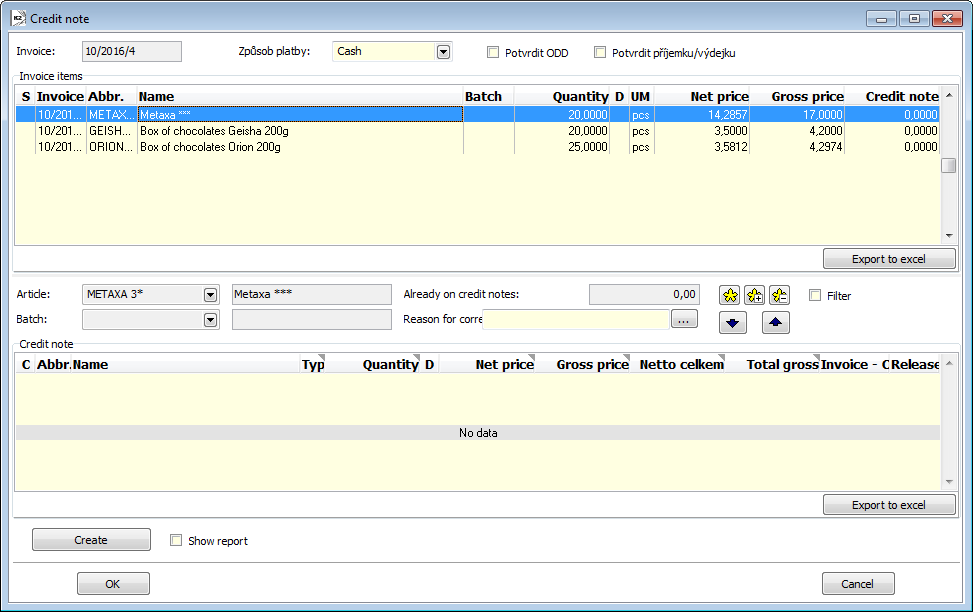
Picture: Credit Notes form
Fields Description:
Invoice |
Number of an Invoice which is being processed. |
Payment Method |
Payment method which is added into a new invoice - Credit note. |
Confirm Credit note |
Checkmark, whether you want to confirm a new invoice - Credit note. |
Confirm Receipt card/Release note |
Checkmark, whether you want to confirm a receipt card/release note - Credit note. |
Invoice Items |
There are all items of the Invoice displayed in this window. |
Article |
An abbreviation and a name of Article from the Invoice Item. |
Batch |
An abbreviation and a description of the Batch from the Invoice Item. |
Already on credit notes |
Number of pieces that has already been credited on this item of this Invoice. |
Filter |
If the field is checked, only Credit notes, that are related to the Invoice item on that the light indicator is positioned, are displayed in the lower part of the form. If this field is not checked, the already created Credit Notes to all Invoice Items are displayed here. |
Reason for correction |
The field for entering a reason of the correction. It is possible to edit it, select the existing reason of the correction from the code list or insert a new record into the code list. |
Credit note |
In this form window we work with the selected Invoice items when creating the Credit notes. Further, the already existing Credit notes to a selected Invoice or to its items are displayed here. |
Show report |
If the field is checked, the Invoice Out report will be displayed after creating the Credit note. |
The customer returns 10 pcs of "Metaxa" article. Work with this item. In the upper part of this form, it is necessary to indicate the items, that you want to make credited, by asterisks. Indicate it by pressing the
Shift+Enter keys or by means of the standard icons with the asterisks in the form. Move the indicated items from the upper part of the form into the bottom window by means of the buttons with arrows. The selected items can be edited in the lower part of this form.
Picture: The Credit notes form with a credited item - correction of quantity
Number of pieces of the credited Articles is defined in the
Quantity column. In the case that a Credit note for correcting price is creating, the Net Price and Gross Price columns are used to define a new Article price. The columns can be edited by the Enter key.In this case, when there is quantity correction, only the
Quantity column has to be edited. Here specify the number of pieces which have been returned by the customer, it means 10 pcs of the "Metaxa" article. Save the created Credit Note by pressing Create button. By pressing OK button save the document and simultaneously close the form of this function.A new Invoice and a Release Note with one negative item have been created by this script. The same negative item is automatically inserted also on an original Sales Order.
By creating a Credit note, the negative item -10 x 14.29 GBP has been inserted into the Sales order. The Net Price has been reduced by 142.86 GBP.

Picture: The Sales Order with a negative item - correction of quantity
After creating the Credit Note, it is possible to print an Invoice Out
standard report over the already created Invoice.
If the TaxCreditNoteConfirmation parameter is set on "Yes" on the Invoice, the Confirmation of receipt of credit note is printed with the Invoice as an attachment.
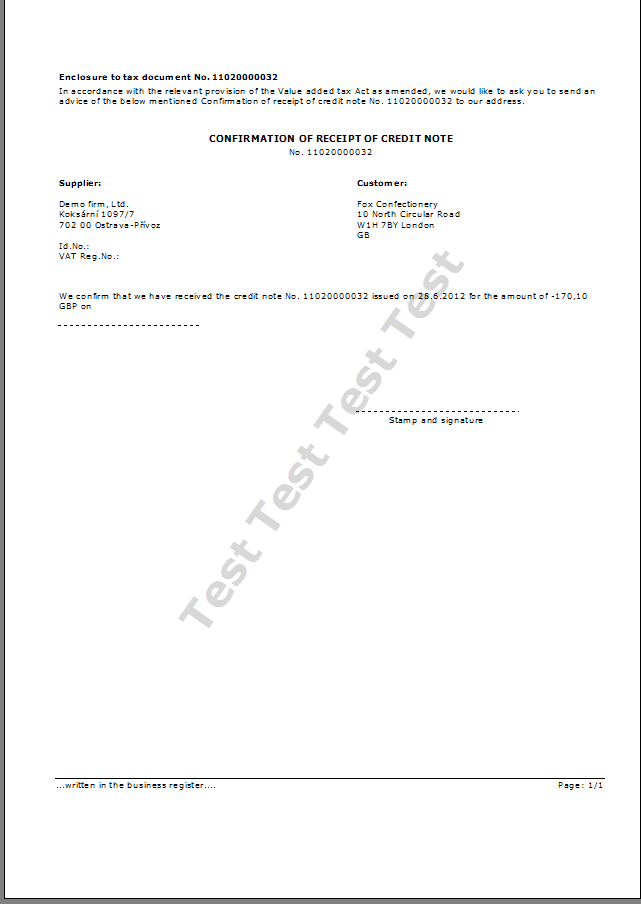
Note:
In the case, that you need to correct the quantity and the price too, enter a new price in the bottom part of the form - a type on an item will be automatically change to "P", change it back to "Q".
If a credit note to an item, on which an invalid article card is, is created, then after the approval of the form, the message will be displayed: "There are some invalid articles cards on the created credit note...". The credit note for this article is created after the approval of this message
.Correct the Price
Example: A Sales order for articles in the value of 340.00 GBP without VAT is created. The Invoice has been issued for the items of this sales order and the articles has been physically taken out from a warehouse (the Release Note has been created). One of the Sales Order items is for 10 pcs of the "Metaxa" article for the net price of 19.00 GBP (22.61 GBP incl. VAT). The customer requires a discount for 5 faulty pieces of this article. A new net price of this article is 9.50 GBP. It is necessary to create a credit note with the price correction of 5 pcs of the "Metaxa" article.
Indicate the article in the form for creation of the Credit note and move the item into the bottom window by means of the buttons with arrows. You correct the price, that´s why it is necessary to edit not only the Quantity column but also one of the Net price, Gross price, Total net price, Total Gross price columns. Determine a new article price in these columns.
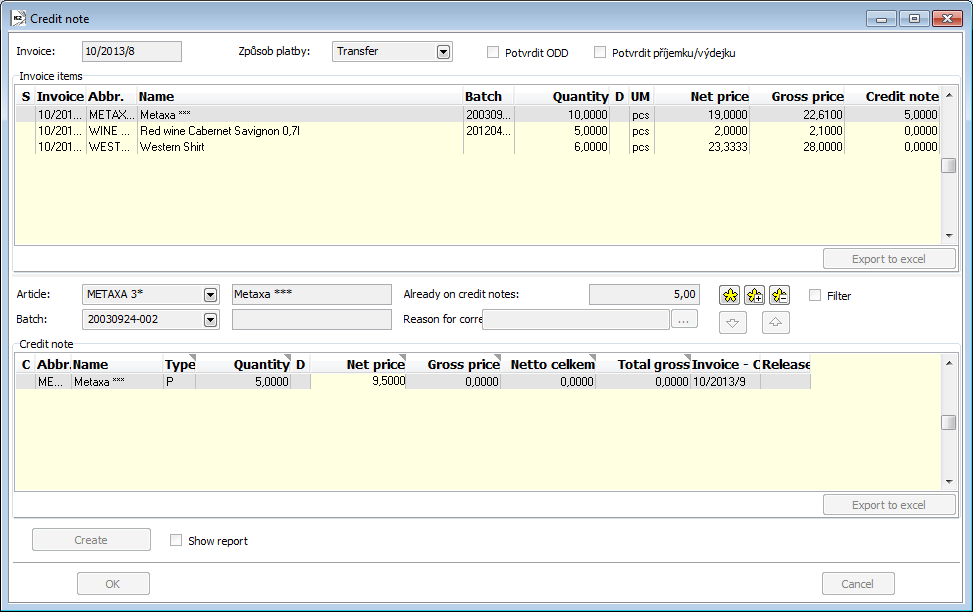
Picture: Credit Notes form - price correction
The new price of Metaxa is defined on 9.50 GBP/pc without VAT, because of that it is necessary to fill the Net price column.
Fill in the number of pieces of the appropriate article into the
Quantity column. The "P" letter (correction of the price) is automatically inserted into the Type column.The Invoice (credit note) is created by the script. The Invoice contains one negative item with the original price (-5 pcs x 19.00 GBP) and one positive item with the new price (5 pcs x 9.50 GBP). Both of these items are inserted into the original Sales Order and they decrease its value by this way. In the case of correction of the price, the articles are not returned physically, therefore the Release Note is not created.

Picture: Sales Order - correct the price
If you
want to create a 100% price credit note, change the
Type to "P" in the form and leave a price of zero.Create Credit Notes in bulk
If you want to create the Credit Note to more Invoices at once, the Invoices must satisfy the following conditions:
- they must be issued for the same company,
- they must have the identical type of tax in a heading,
- they must have set the Currency checkbox identically and if the Currency checkbox is checked on all Invoices, it must be the identical currency,
- if the CreateNewCommission parameter is set on "No", all Invoices must be issued in the identical book,
- if the Invoices are not issued in an identical book, the Allow multi docs/Allow adding superior document from other book client parameter must be set on "Yes".
If the Invoices do not satisfy any from these conditions mentioned above, the function will display the reason, why it is not possible to run it, and will be close. If the Invoices satisfy all the mentioned conditions, the input form of the function for creating a Credit note will be displayed. In this input form, there the quantity, eventually the price which you want to credit, is specified. How to specify the quantity is mentioned above.
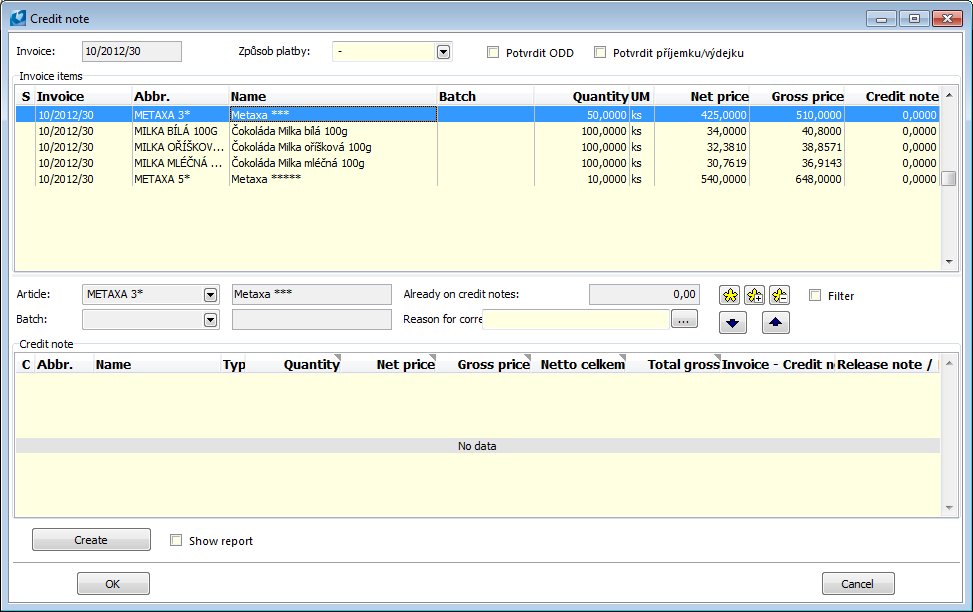
Picture: Credit Note form
After approval of the form, a new Invoice is created. When creating Credit Notes to more Invoices at once in bulk, the fields, that have been taken into the Credit Note from an original Invoice, will be taken as follows:
- if the invoices indicated by asterisks are processed and when activating the script, the light indicator has been positioned on another Invoice (not on Invoice indicated by asterisks), the heading data will be taken from the first Invoice indicated by asterisks. Otherwise, the heading data will be taken from a record on that the light indicator has been positioned when activating the script,
- if the Credit Notes is created in a foreign currency to one Invoice, the exchange rate will be entered from the original Invoice (as till this time). If the Credit Note is created to more Invoices, the exchange rate from an Exchange list, that has been valid to the 1st of January of the current year, will be entered into the Credit Note - foreign exchange center (if there is no exchange rate to the 1st of January in the Exchange list, the nearest preceding one is taken).
The Invoice, from which the fields are taken for the new Invoice, are stated in the heading of the form in the Invoice field. A supplement of the "VS" type is inserted into the item of a new created document. One supplement is created for each original Invoice from which a Credit Note has been created. A reference number of an original invoice is inserted into a description and a number of an original invoice in the Book/BusinessYear/Number format is saved into a long text. It is possible to set what will be printed by the ShowFormerInvoice parameter in the Invoice Out print report (VF_DOK01.AM).
A new created Invoice is linked with all Invoices, from whose items the Credit Note has been issued, through the 9th page.
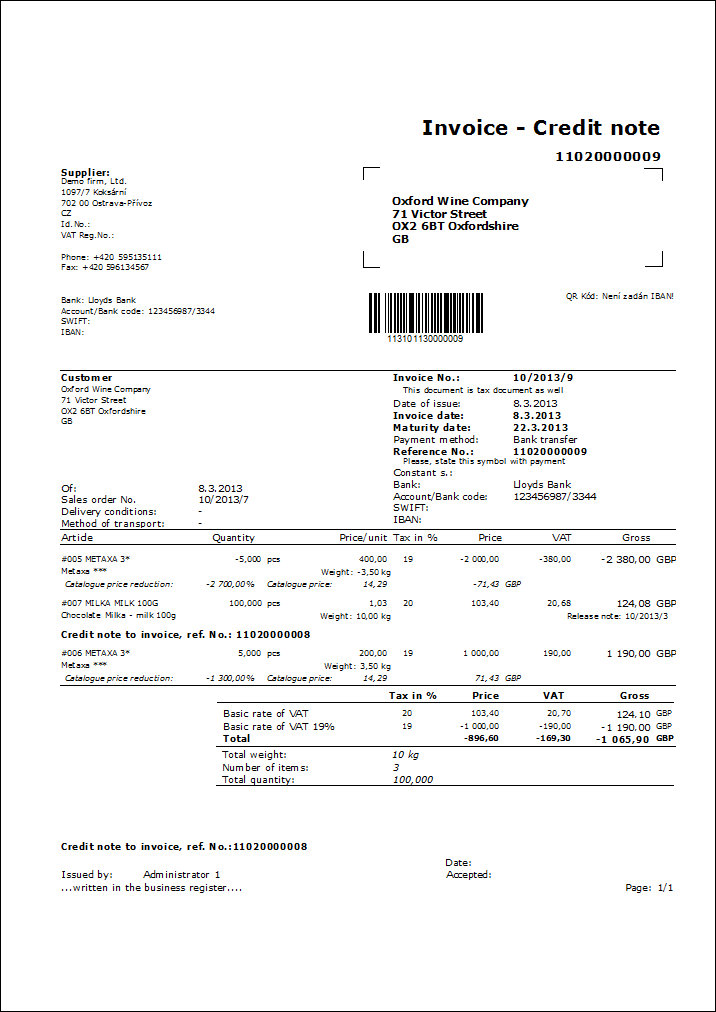
Creation stock documents only
By means of the Corrective Tax Documents function (FA_DOB.pas), it is also possible to create the stock documents only. The CreateInvoice parameter has been created. This parameter enables to suppress creation new Invoices. If the CreateInvoice parameter is set on "No", you can check the Display Report checkbox in the input form. Otherwise, it is worked identically.
If the CreateInvoice parameter is set on "No", only the Stock documents will be created. The reference to the origin invoices is inserted on 9th page of these stock documents (simultaneously as on an Invoice - Credit Note). The references to the created stock documents are inserted into the 9th page of the origin Invoices (Relation type = "Corrective Tax Document").
If you want to create the Invoices later, you can use the Sale Items (Purchase Items) standard tool of the K2. Here you can select the "Not invoiced credited items" predefined selection that displays the items of the Sales Orders to which there is a credited confirmed Release Note and which have not been invoiced yet (an Invoice does not exist).

Picture: List of predefined selections
After pressing a selected selection, a form where you can select a customer for who you want to create the credited Invoice from a Release Note, is displayed.

Picture: Form for selection a Customer in the Not invoiced credited items selection
A list of all credited items of the Sales Order is displayed. It is for a selected customer to whom a confirmed Release Note exists and an Invoice does not exist.
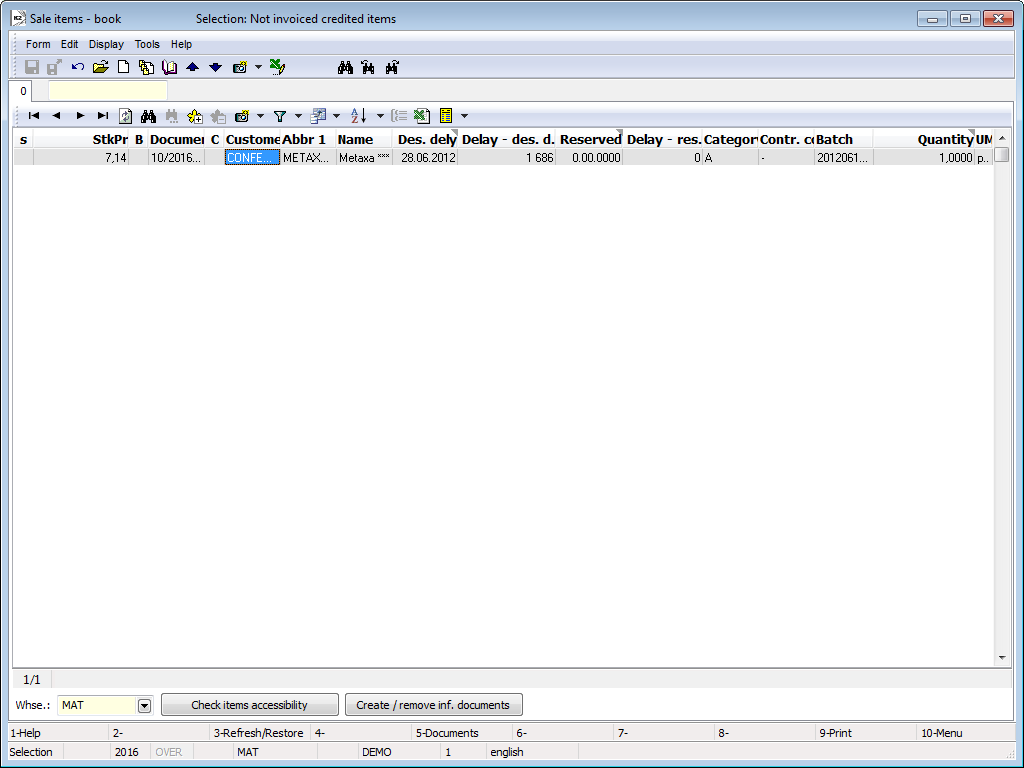
Picture: List of all credited items for a selected customer
After that, indicate by asterisks the items to which you want to create an Invoice - Corrective Tax Document, press F5 key (Creation Documents) and check in the form that you want to create the Invoice. It is also suitable to check the option to create a filter of documents, to be the created Invoice easy found subsequently, and press the OK button.
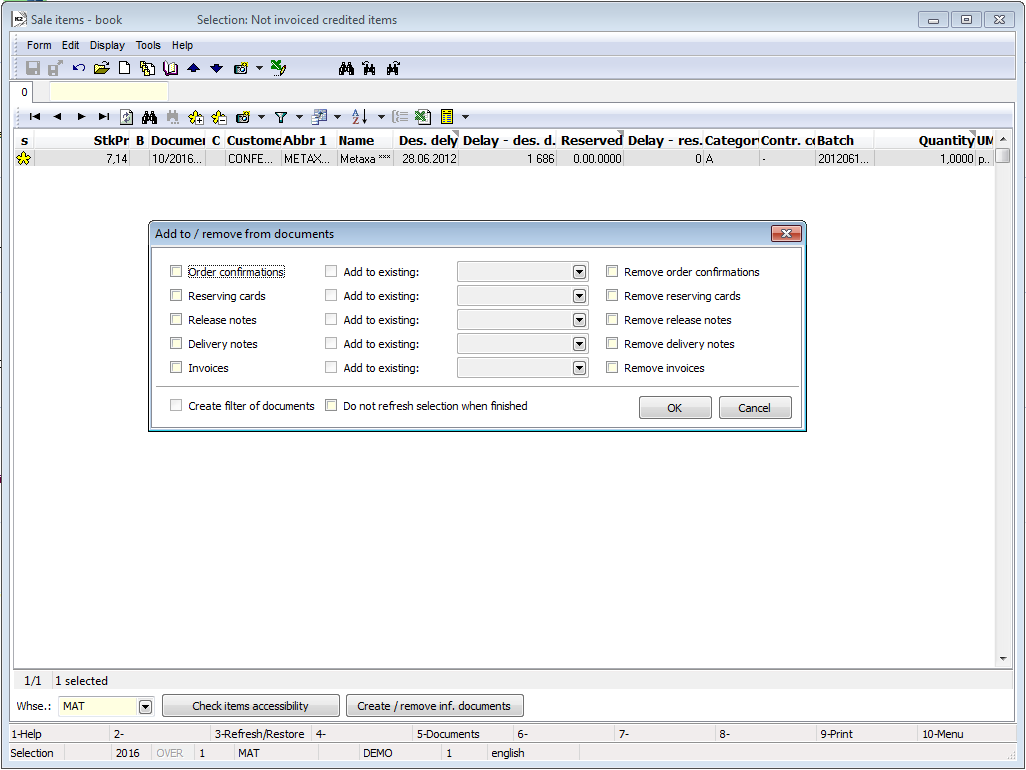
Picture: Creation Invoices from Sale items
In the Invoices Out book, switch the filter on where there is a created credited Invoice. It is necessary to check the Corrective Tax Doc checkbox in the Invoice and confirm and press the Invoice.
Posting - SALE
Repair of price
Invoice out |
311/604 311/343 |
10pcs x 5000,- |
50 000,- 10 000,- |
Invoice out (corr. tax doc.) |
311/604 311/343 |
-5pcs x 5000,- |
-25 000,- -5 000,- |
|
311/604 311/343 |
5pcs x 2000,- |
10 000,- 2 000,- |
Repair of quantity
Invoice in |
111/321 343/321 |
10pcs x 5000,- |
50 000,- 10 000,- |
Invoice in (corr. tax doc.) |
111/321 343/321 |
-5pcs x 5000,- |
-25 000,- -5 000,- |
Credit Notes
Process No.: EXP014 |
Script Id: FEXP017 |
File: FA_DOB.PAS |
Script description: The function ensures the creation of credit notes to the invoice items and advances and their interlinking. It is possible to use it in bulk to more invoices, a stock document can be created only. Principle of solution lies in the fact that a new Invoice (credit note), which includes one or two items in dependence on the fact whether it is a correction of quantity or a correction of price, is created to the original invoice, resp. its item. |
||
Address in the tree: [Finance] [Credit Notes] |
||
Script parameters:
ArticleFilter - No Yes - only items from the articles filter are displayed in a start form. |
ConfirmInvoice - No Yes - a newly created invoice (a credit note) and an advance (a credit note.) are confirmed. |
ConfirmNewCommission - No Yes - if the CreateNewCommission parameter is set on Yes and all inferior documents are confirmed, a newly created Sales order is confirmed too. |
ConfirmRel - No Yes - a newly created receipt card / release note is confirmed. |
ContractCode_VY - An abbreviation of a contract code for a new created release note. |
CorrTaxTypes - No Yes - a tax type is changed on a new created invoice (it is used for Slovak legislation). |
CreatedDocuments Parameter is used for an internal programming usage only. |
CopyPaymentCondition - Yes No - the payment conditions are not copied into a new invoice - credit note. |
CreateInvoice - Yes No - a new invoice - credit note - is not created. It is used, when you want to create stock documents only. |
CreateNewCommission - No The parameter has got meaning only at the invoices out and invoices in. Yes - a new sales order / order is created too. The items are not inserted into an original sales order / order; No - a new sales order/order is not created. |
CreateStockDoc - Yes Yes - a receipt card/release note is created for an invoice. |
EmptyInvoiceDate - No Yes - the zero invoice date is filled into the new invoice. |
IgnoreReceiptPrice_VY - No Yes - the Ignore receipt prices parameter is set on a release note upon valuing by sliding price or upon valuing according to the batches. |
IncidentalCost - Yes Yes - items of the price credit note are marked as Incidental cost on Invoice In. |
InvoicePostingKey An abbreviation on a posting key for an invoice - for a credit note. |
LinkForOriginalInvoice - No Yes - link for the original document is added into the items and to the 9th page of the created credit note. (It has meaning for the recurring price credit notes.) |
NameOfReasonToDescr - No Yes - the reason of a correction is inserted into Description of an invoice - Credit note and sales order (if the new one is created). If the reason of a correction is saved in a code list, then Name from a code list is inserted into Description. |
NewAdvanceBook_PZ Setting of the book of Sale in which the advances - credit notes - will be created. |
NewAdvanceBook_VZ Setting of the book of Purchase in which the advances - credit notes - will be created. |
NewCommissionBook_PF Setting of the book of Purchase in which the credit notes will be created. |
NewCommissionBook_VF Setting of the book of Sale in which the credit notes will be created. |
NoInteractive - No Yes - a credit note is created to all invoice items without displaying a form. |
NoInteractiveXml Parameter is used for an internal programming usage only. |
PrintReport - No The parameter for pre-setting the "Show report" flag. It is possible to display the report even if the "NoInteractive" parameter is set on the value "Yes". |
ReasonForCorrection The parameter for pre-setting the reason for correction - it will be displayed in the input form. |
ReportNumber The parameter for entering the number of the print report in F9 (for printing the report with the set print parameters). |
ReportPath_PF Parameter for printing the special Invoice In report. It is necessary to enter the whole path to the saved report. |
ReportPath_PZ Parameter for printing the special Advance Received report. It is necessary to enter the whole path to the saved report. |
ReportPath_VF Parameter for the printing the special Invoice out report. It is necessary to enter the whole path to the saved report. |
ReportPath_VZ Parameter for printing the special Advance Provided report. It is necessary to enter the whole path to the saved report. |
ShowOnlyToCreditNote - No Yes - only items, which may be credited, are displayed in a start form. |
Stock_PF - 0 The parameter serves for setting a number of the stock where the receipt cards will be created. |
Stock_VF - 0 The parameter serves for setting a number of the stock where the release notes will be created. |
TestPodokna - No Debug parameter. |
Credit notes in subview window
You can display the corr. tax documents in a sub view pane on the zero and on the 2nd page of the invoices. If a corr. tax doc. is created to an invoice, the corr. tax doc. will display in the sub view pane.

Picture: The sub view of Credit notes
In the subview window, an item of the newly created credit note is displayed. In the column Type is the character M. That means that a document with repair of quantity was created. By double click by the mouse in the subview window in the column Invoice - Credit note you display a detail of an invoice (corr. tax doc.) and a light indicator will be set on the concrete item of this document. You can display a detail of created stock document by double click by the mouse on a record in the column Release note / Receipt card.
If a sub preview is not displayed, you have to control, if you have got set the user parameter Show subview window.
If you have got set parameter for display of the sub preview and the sub preview is not displayed, you have to set the scripts:
In the Invoices out book in the main menu in the Display tab you open the Subview window definition. The Reports window displays. In the window you press an Insert keyword for inserting a new record - the Reports book will open, after that you will close the window. The 1st page displays in the window for a newly inserted report and in its upper part you click on a yellow folder for opening file. In the database system you choose the script with name „FA_ItemConn_Form_Page0.PAS“ and you set it these parameters:
- Preview_PageNames with the value „STRANA0",
- Preview_GridName with the value „FGRID0".
That it is possible to display a subview window on the 2nd page too, you have to classify the „FA_ItemConn_Form_Page2.PAS“ script to a definition of the subview window with these parameters:
- Preview_PageNames with the value „STRANA2",
- Preview_GridName with the value „FGRID21".
You have to repeat this process everywhere where you want to have shown the subview window Credit notes. That means in the invoices out, invoices in.
At the Advances received and the Advances provided for the zero and the 2nd page the „FA_ItemConn_Form_Page0.PAS“ script is used. Setting of the zero page is analogous as at the Invoices out. For display of subview window on the 2nd page of an advance you have to set these parameters:
- Preview_PageNames with the value „STRANA2",
- Preview_GridName with the value „FGRID0".
Methodologies of Invoices out
Rounding Inland Invoices Depending on Payment Method
It is possible to set the rounding depending on the filled Payment method for Invoices Out in the inland currency. Rounding is set in the Payment method code list displayed in the Browse mode on the Invoice out. The value, which should be added or deducted to the rounding number before the rounding (it enables rounding up or down), is entered to the Constant field. To the Order field enter a value to which it should be rounded.
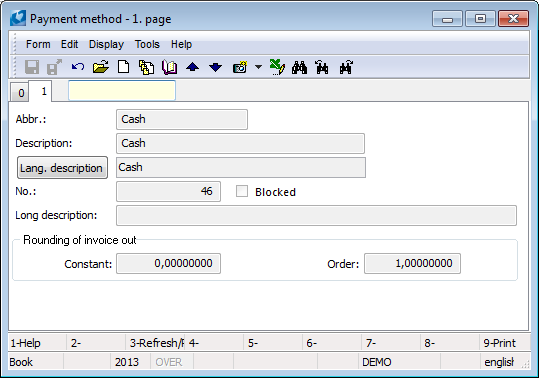
Picture: The Set-up of the rounding for a payment method form
When setting the rounding according to the picture, it will be achieved the rounding to integer units. If you want to round to the integer "5euros", write the value 5 into the Order field.
Rounding is executed during creating an invoice out, in which the selected payment method is set, or when changing a payment method, in which case it has to be an inland invoice (the option Currency is not checked) on which the option Not round is not checked (on the Tax summary tab). The rounding difference will be allocated to the values of Net and to one of the VAT rates.
Reports - Invoices out
Invoice Out
Process No.: EXP009 |
Report ID: SZAK009 |
File: VF_DOK01.AM |
Report description: Invoice Out |
||
Address in the tree: [Sale/Processing of sales orders] [Invoices Out] [Print reports - Lists] |
||
Report parameters:
Assignement - No Yes - the posting of documents is displayed (data from the 3rd page of the document). |
BankContacts - 3 0 - the information about a bank connection is not displayed; 1 - the information is displayed only in the heading; 2 - only in the part of the form over the items; 3 - the information about a bank connection is displayed in the heading and also in the part of the form over the items. |
BarCode - Yes Yes - bar code is displayed. |
Batch - No Yes - batches for an item are displayed. |
BatchAttr - 1 0 - Nothing is displayed; 1 - batch parameters are displayed; 2 - required batch parameters are displayed. |
BusinessRegister - Yes Information about the Business register from the Configure own companies are displayed. No - it is not displayed. |
CataloguePrice - Yes Yes - it displays the catalogue prices at the items. |
CodeOfCurrency - No Yes - a code of currency is displayed (e.g. USD). Yes - a sign of currency is displayed (e.g. $). |
CombineOrigItem - Yes Yes - it combines items with the same "OrigItemF" (if there is no difference in a price and in some other attributes). |
Contacts - 1;Addr;TaxNum;Tel1;Fax1;Email1;WWW Parameter has a total of 10 positions, the first three are firmly set: 1. position: a user, whose contacts from the user´s card (telephone, mobile, fax, email) are printed. Options: 0 - no user´s contacts, 1 - the user, who has issued the document, 2 - the currently logged-in user - who prints a document. 2. position: "Addr" - if it is entered, an address of the firm is displayed. 3. position: "TaxNum" - if it is entered, the ID-No. and VAT Reg.No. are displayed. 4. - 10. position: listed types of electronic addresses of the own company (ie. there may be up to 7 types). Example: (Contacts - 1;Addr;;TEL1;FAX1;WWW1): The address of a firm is displayed, under it the contacts from a card of the user, who has issued the document, (Tax No. are omitted by empty string on the 3rd position) electronic addresses with the types Tel1, Fax1, WWW1 follow. Note: If some of the data are suppressed, no free place will remain. The default order in a report is always: address, Tax No., user's contacts, the entered electronic addresses of the own company. |
DefaultExport - No This parameter is described with the other export parameters in the Report parameters for a bulk sending by email chapter. |
Description - No Yes - information from the Description field from the 1st page of the document is displayed. |
DescriptionFromItem - No Yes - a supplement, that is entered into the Description field on an item of a document, is displayed. |
Discount - Yes Yes - a discount entered in an item is displayed. |
DraftLabel - Yes Yes - a "DRAFT" is displayed at the background of the report, if a document is unconfirmed. No - a "DRAFT" is not displayed. |
Export_... - various parameters The export parameters, that are collectively described for all documents in the Report parameters for a bulk sending by email chapter, are a part of the report too. |
FormerInvoice - 1 A reference to the original invoice is displayed in the form: 0 - reference number, 1 - number, 2 - reference number when printing the invoice as a Credit note. |
Interactive - No No - an input form for entering parameters values is displayed. |
ISDOC_AccountsBetweenPartners - Methods of payments in the K2 for the payment accounts between partners (separated by semicolon). |
ISDOC_CurrentCompany - 0 Identification (company number) in the Customers. |
ISDOC_DeliveryNoteType - 1 Which reference should be exported from an Invoice item: 1 - Delivery Note; 2 - Release Note. |
ISDOC_DocSupplementType - ALL Document type which is going to be exported. |
ISDOC_NonTaxedType - N An Abbreviation of a Tax type in the K2, for "Not in declaration of taxes" type. |
ISDOC_Path - C:\ A path for a file export. |
ISDOC_PaymentsByCreditCard - Methods of payments in the K2 for a payment by a credit card (separated by semicolon). |
ISDOC_PaymentsByCheck - Methods of payments in the K2 for a payment by a check (separated by semicolon). |
ISDOC_PaymentsInCash - Methods of payments in the K2 for a payment in cash (separated by semicolon). |
ISDOC_SuppressPicture - Yes No - a bitmap is not displayed in the heading for ISDOC. |
ISDOC_TransferToAccount - Methods of payments in the K2 for a payment by a bank transfer (separated by semicolon). |
Items - Yes No - all items of document are hidden. Instead of the items, the user can print his/her own text that is defined e.g. in a supplement of the customer. Tax summary is not affected by this parameter. |
JCKindItem - A list of the kinds that are printed in a tree of the Job Cards (it is necessary to separate more kinds by a semicolon). |
JCTreeLevel - 1 0 - all levels of Job Cards are displayed on the items; 1 - without the Job Cards 2,3,4... - number of levels. |
KeepEnvelopeFormat - No No - a blank space under a place for envelope window is hidden. Effect of a saved space is multiplied if the "BarCode" parameter is set on "No". It has meaning, if the user does not use the window envelopes, he does not want to fold the printed document to an envelope according to the cam line guide of a document. Yes - a place is not hidden - the line between items and the address part will always be in one third of a page. |
LangAccordtoParams - No If the report should be printed in a language, that is set in the "Field language" and "Report language" parameters, then a value of the parameter has to be set on "Yes". |
LeftEnvelopeWindow - No Yes - address of a customer is printed in the right side (determined for sending documents by mail in abroad where a window for an envelope is in the left side); No - address of a customer is on the left side. |
LeftShift - 5 By how many mm the edge of the report will be moved to the left (it serves for setting a print on a printer). |
LogoPictureFooter - 0 Parameter adjusts the footer logo display. If the parameter is empty, a logo according to the setting of the Footer picture parameter in the Administration - setting of own companies function will be displayed. 0 - nothing is displayed, but a place keeps free (for a headed paper), 1 - neither any picture nor free space. Name of a file with png suffix - specific picture in the Pictures directory of the given firm. |
LogoPictureHeader - Parameter adjusts the header logo display. If the parameter is empty, a logo according to the setting of the Header picture parameter in the Administration - setting of own companies function will be displayed. 0 - nothing is displayed, but a place keeps free (for a headed paper), 1 - neither any picture nor free space. Name of a file with png suffix - specific picture in the Pictures directory of the given firm. |
NumberOfDocOnItem - 1 0 - nothing is displayed, 1 - the number of a release note is displayed on an item, 2 - the number of a delivery note is displayed on an item. |
NumberOfItem - 1 0 - no number is displayed, 1 - number of a sales order item is displayed; 2 - order number is displayed. Always in "#001" format. |
OneLineItem - No Yes - document item is always displayed in 1 line. |
OwnCurrency - 0 0 - the information about a recalculation of the tax recapitulation is not displayed; 1- only an Exchange Rate is displayed; 2 - a tax recapitulation that is recalculated into a currency of the company is displayed; 3 - a recalculation of the Tax recapitulation and an Exchange rate of the recapitulation are displayed. If the tax recapitulation is not in a different currency than the currency of the company is, neither the recapitulation nor the Exchange Rate is displayed regardless of the parameter value. |
Payment - 0 0 - no added print, 1 - the "Deffered payments" line is displayed under the tax recapitulation, 1 - the "Suspensions" line is displayed under the tax recapitulation. |
QRBankOrder - Yes Yes - the QR code is displayed. The code contains the values: the account number, the amount, a currency, a Reference Number, a Constant symbol, Due Date, a Message for a recipient. If some of the values will be missing, it will not be inserted into the code. |
SerialNumber - No Yes - the serial numbers are displayed at the items. |
Sign - Sign - @vyst;27;47;0;83 Parameter has 5 positions: 1. position determines a person whose signature should be displayed. It may be a picture called according to the Logname of a user, who has issued the document (@Vyst) or who prints the document - so according to the current login (@akt), or the current Logname. Picture has to always be in Logname.png format and it has to be located in Pictures directory. 2. position: picture height. 3. position: distance from the left edge. 4. position: distance of a picture from the upper edge of the given section. 5. position: picture width. Example: (Sign - @vyst;27;47;0;83) It prints a signature of a user who has issued the document, 27 points high, 47 points indented from the left margin, at the upper margin. A picture is 83 points wide. |
SortBy - The field is filled with the value of the field from the sales items (e.g. C_Zbo;Zkr or CF_CeJePlM). Items on a document will be sorted according to the parameter value. Parameter is empty by default. If the value of this parameter is entered, then the items will not be combined, even if the CombineOrigItem parameter is set on Yes. |
StateOfOrigin - No Yes - a code of tariff and a state of origin are displayed at the items. If it is filled on a batch, information from a batch are displayed; otherwise the data from the Article card are displayed. |
SupplFromArticles - 0 0 - Nothing is displayed, Empty value - Business text from the Article card is displayed, otherwise the entered type of a supplement from the Articles card (e.g. supplement of the DB type) is displayed. |
SupplFromClient - TEXT The TEXT value displays an information from the General information field from the own company. Otherwise the entered type of a supplement from the Client parameters is displayed. |
SupplFromCustomer - DZ 0 - Nothing is displayed, Empty value - Business text from the Customer card is displayed, otherwise the entered type of a supplement from the Customer card (e.g. supplement of the DZ type) is displayed. |
SupplFromItem - TX 0 - Nothing is displayed, empty value - text from the Text tab from a document item is displayed, otherwise the entered type of supplement from an item is displayed. |
TaxCreditNoteConfirmation - No Yes - confirmation of receipt of the Credit note is displayed. |
Title - The entered value of the parameter is displayed as a title of the report. If the parameter is empty, an original name of a document is printed (e.g. Invoice). |
VATExemptSupplies - Yes The "VAT-exempt supplies" text is displayed in the tax recapitulation, if it is a VAT exempt supplies (according to the Tax type). |
Warranty - No Yes - the number of months of a warranty from an item is displayed. If the value '999' is entered on the item, the warranty will be displayed as text "Lifetime". |
Weight - No Yes - a weight of the individual items and a total weight of a "document" are displayed. |
